We spent 6 weeks slowly exploring the southern part of Spain called Andalucia (Andalusia). We chose to travel to Malaga, Rhonda, Córdoba, Granada, and Seville. By accident, we visited these cities in what I think was the perfect order. This region once was part of the Roman Empire, then an impressive Muslim stronghold before being overtaken by the Christians. Many impressive sites related to this interesting history can be seen throughout Andalucia.
Malaga
We started in Málaga simply because this is where we found a good flight into Andalucia, Spain. We only spent a few days here which we filled with sightseeing. We saw our first Roman site and two fortresses from the Arab time which were later used by the Christians. Christians conquered Malaga in 1487. Malaga provided the perfect intro to the history of Andalucia.
Roman Theatre
The Roman Theatre can be found at the base of the Alcazaba fortress. It was built in the 1st century CE and used until the 3rd century. It was discovered in 1951 after being buried underground for centuries. Parts of the theatre were taken and used by the Arabs to build the nearby Alcazaba fortress.
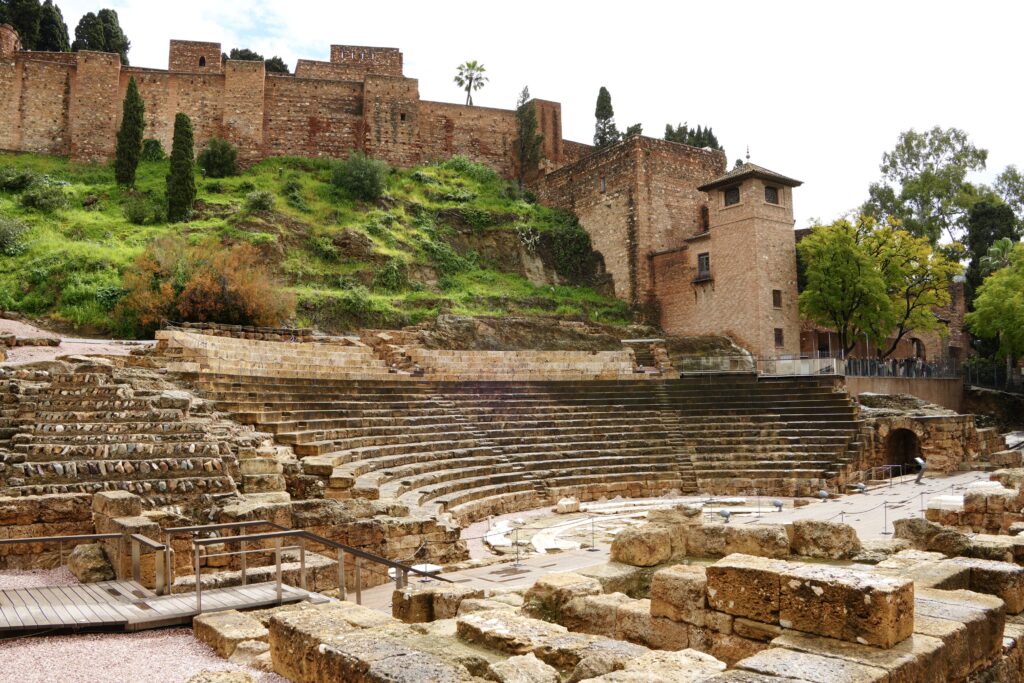
The Alcazaba Fortress
The Alcazaba fortress is an Arab palace and fortress. The first record of the Alcazaba as a defensive fortress was way back in 755 CE. It was turned into a palace residence in the 11th century. It functioned as a small independent medina, separate from the medina of the city. The Alcazaba is actually 2 fortresses, one inside the other.
Wandering through the Alcazaba is a treat. The outer fortress is essentially a walk through a green garden surrounded by high stone walls. Double arched walkways lead you further into the maze. Once you reach the inner area, courtyards and small palaces surround you. Mosaics are built into the cobblestone and doorways and windows have elaborately carved decor.
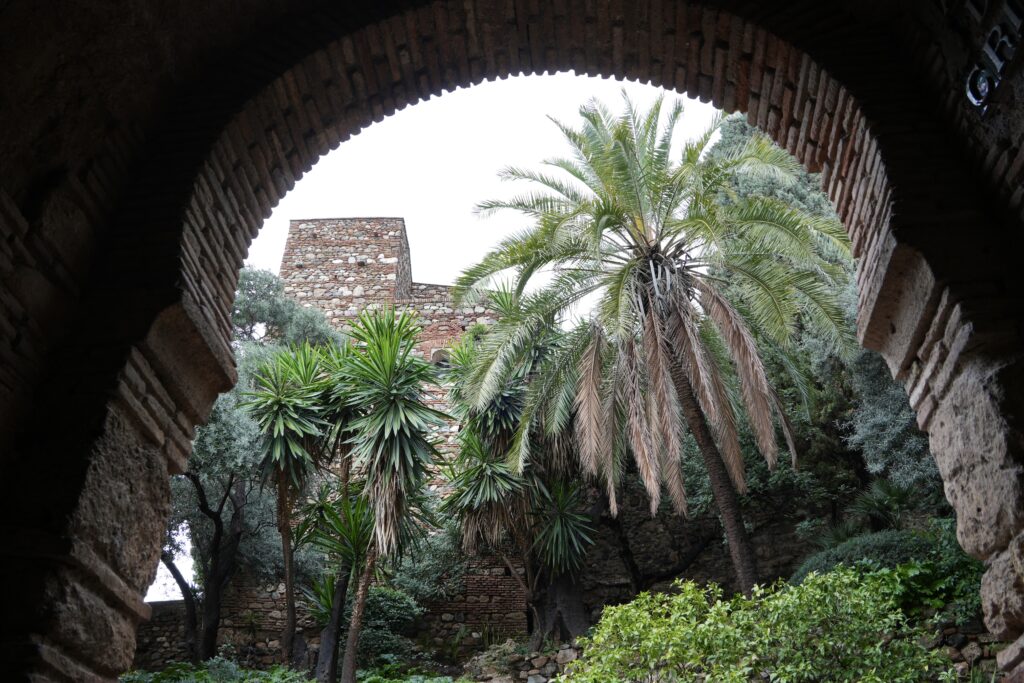
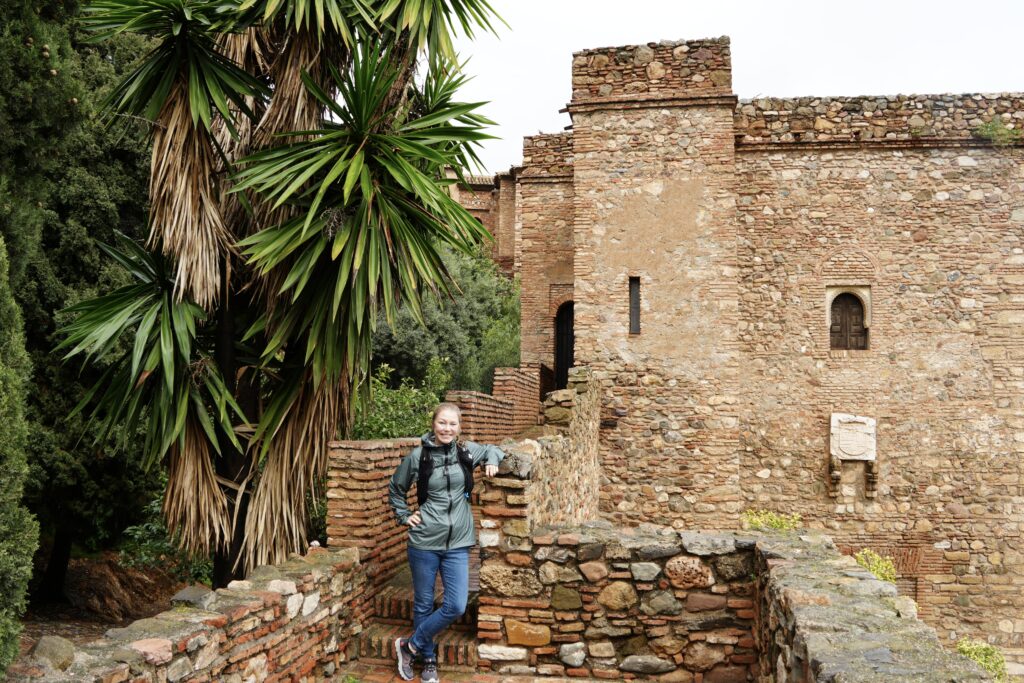
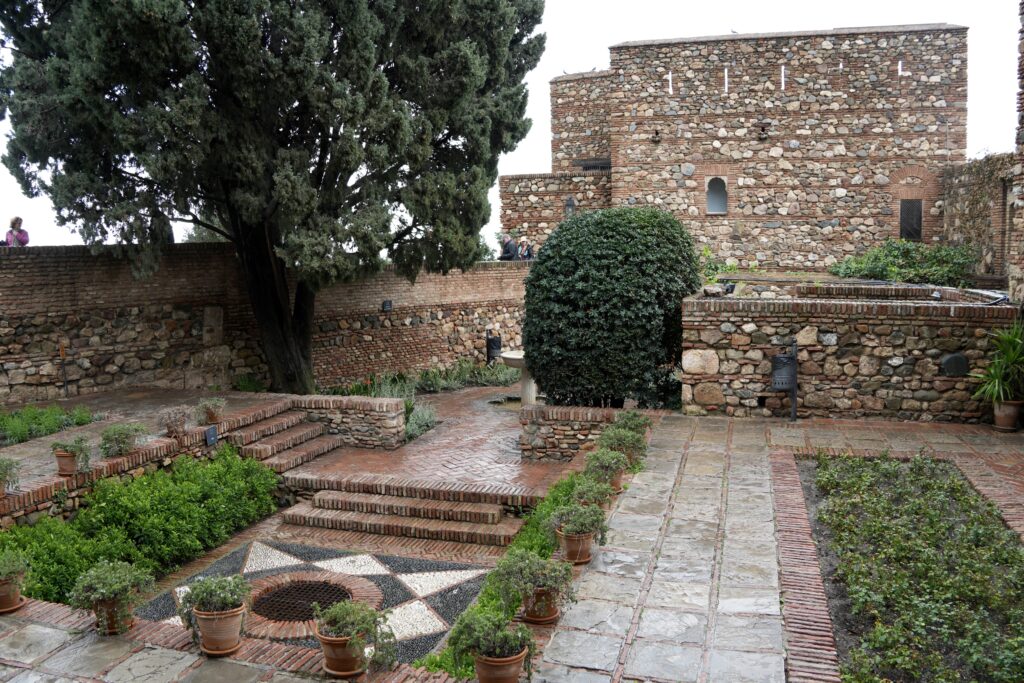
Castillo de Gibralfaro
The Castillo de Gibralfaro is located on a hilltop with views of the whole city, bay, and the Alcazaba. It was built in the 14th century by the Arabs to protect the Alcazaba. It was connected to the Alcazaba through the coracha (a fortified walkway) to a single door which originally was the only entrance to Gibralfaro. Later during Christian times, more access doors were created.
After Gibralfaro was occupied by the Christian troops, its mosque was converted to a church and the fortress was used as a barracks and prison until 1925. During the Spanish War of Independence, the French who had built fortifications in Gibralfaro blew them up as they left. Restoration of the fortress and castle began in 1989.
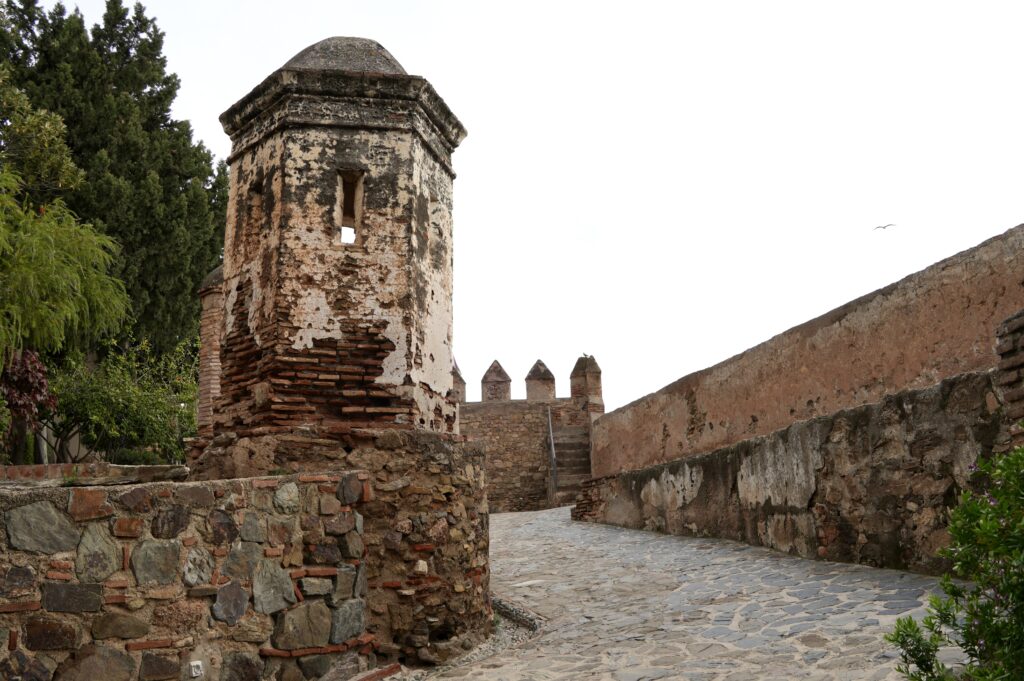
Amazing views over the whole city make it obvious why the Alcazaba Fortress and Castillo de Gibralfaro were built to watch for intrusions into the city.
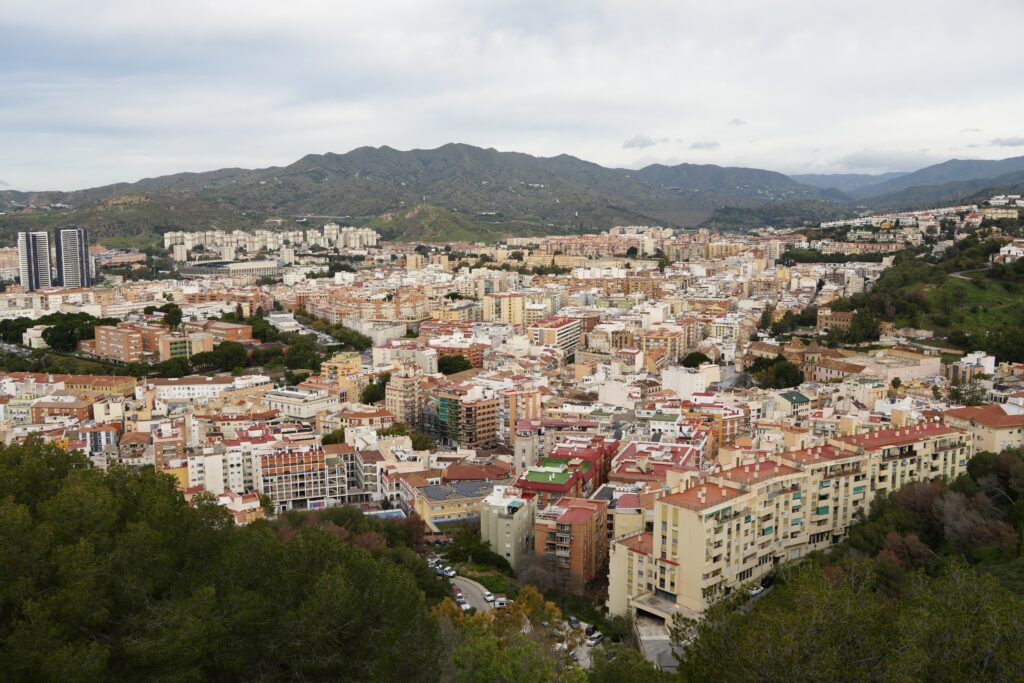
Cathedral of Malaga
The Cathedral of Malaga was built where a mosque once stood. Throughout our time in Spain, we find it is a recurring theme for the Christian monarchs to destroy the Arab mosques and build their churches at the same site after conquering the area. A unique feature of this cathedral is that the south tower is left unfinished. To save money we chose not to go inside this church but we admired the beautiful building from the outside. The cathedral is so large and the buildings around it aren’t that far away. Therefore it is challenging to create a nice photo of the entire structure. Thanks to the ultra-wide angle lens on my phone I managed a photo of the whole front.
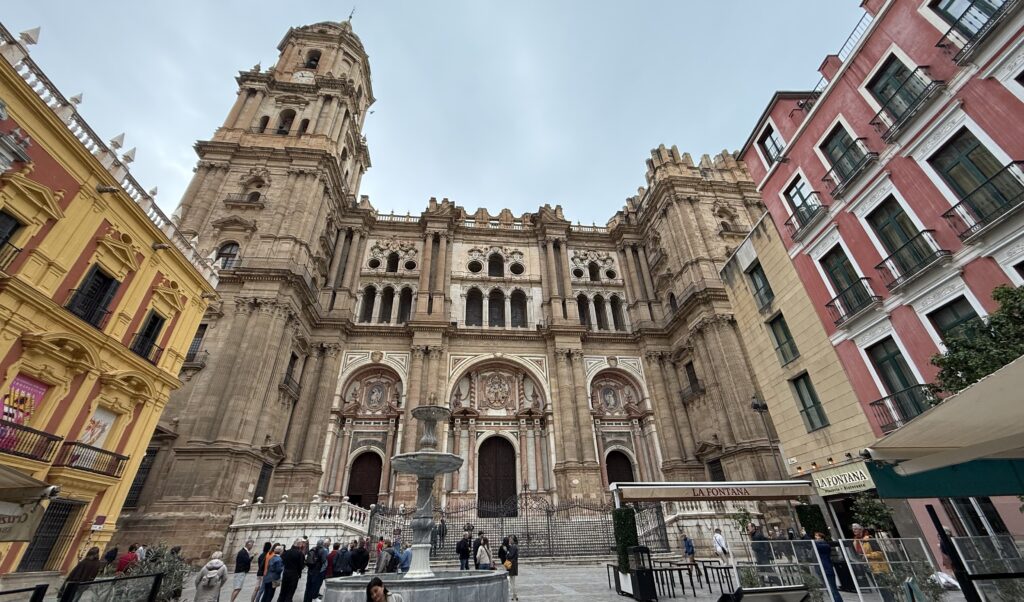
Hiking the Caminito del Rey
We joined a day tour to hike the Caminito del Rey. This is a really cool and easy hike. Much of the trail is hanging from the walls of the sides of the Gaitanes Gorge, about 100 meters above the river below. Below the platforms you stand on, you can see remains of a crumbling original path. The original path was built in 1905 for workers on the hydroelectric dam to access various areas for maintenance. The trail got its name when King Alfonso 13th walked the trail to visit the dam in 1921. It was now known as Caminito del Rey “King’s Little Path”.
Eventually the original walkways were no longer used by the hydroelectric dam workers. Instead they were only used as recreational hiking. This continued as the walkways became increasingly more dangerous due to lack of maintenance, leading to accidents. Therefore the Caminito del Rey was reconstructed and reopened in 2015. It’s now much safer and a fun and beautiful day hike.
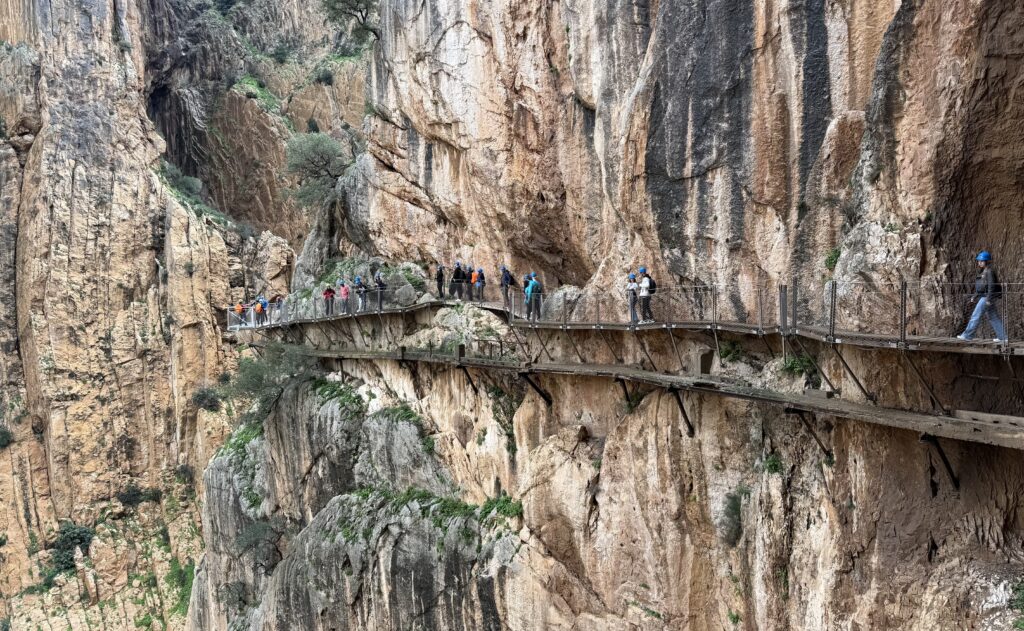
We took an organized tour that picked us up in Malaga. You can do this hike yourself and for much cheaper if you plan ahead. You will need to buy your tickets well in advance because the individual entrance tickets sell out. You can then take the train to the city of Chorro or rent a car and drive to the park. You can purchase tickets at their official site: www.caminitodelrey.info Be sure to check the train schedule before purchasing a ticket if you don’t want to stay overnight in the town of Chorro.
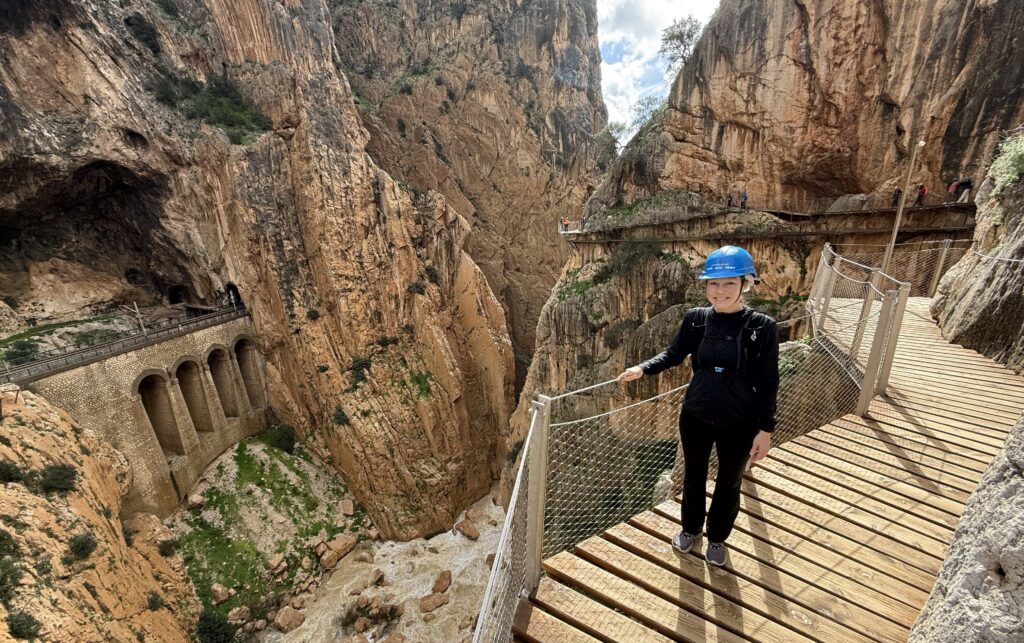
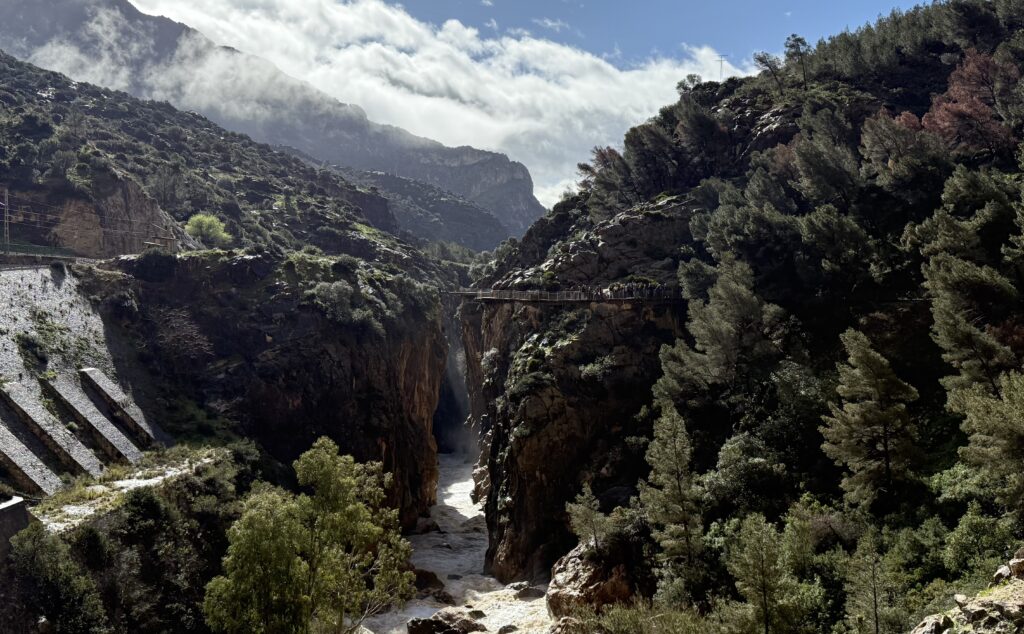
Ronda
We added the small city of Ronda into our itinerary because it is picturesque sitting high up on the cliffs and has a cool looking bridge over a gorge. The city is split in two by this deep gorge and the only connections of those two halves of the city are 3 bridges. We enjoyed this charming little city, loved the views of the bridges, and were impressed with the Arab Baths there.
The Old Bridge
The Old Bridge (Puente Viejo) was built in 1616 and is one of 3 bridges that cross the Guadalevín River, connecting the town across the deep gorge. This stone bridge is only for pedestrians.
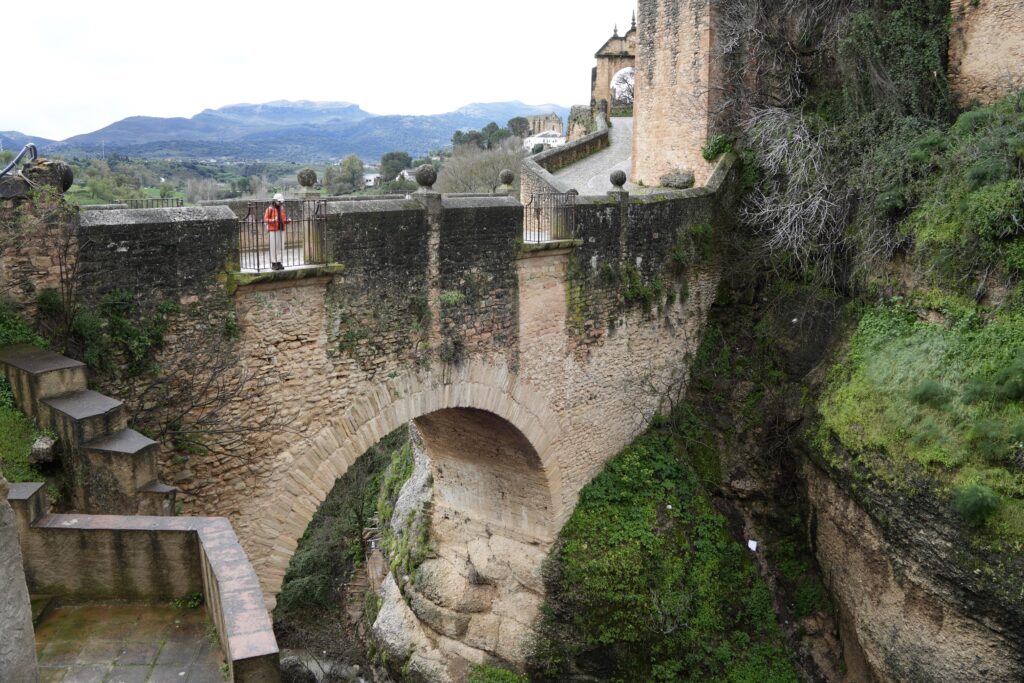
The New Bridge
The New Bridge (Puente Nuevo) is the newest and largest of the 3 bridges in Ronda. It was completed in 1793 and is 98 meters high. The bridge rising up from the gorge so far below is a jaw dropping site. A hiking path leads down from the cliffs and out of town on the southwest side of the bridge. There is a viewing platform that charges for access, but if you hike a bit further down you can get what is likely an even better view for free.
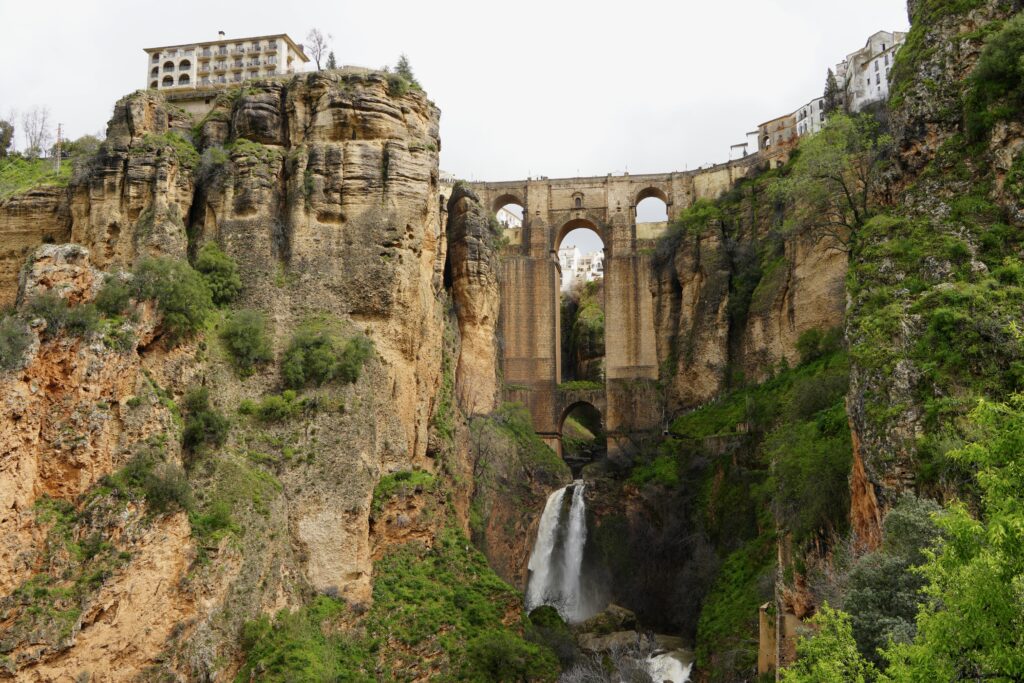
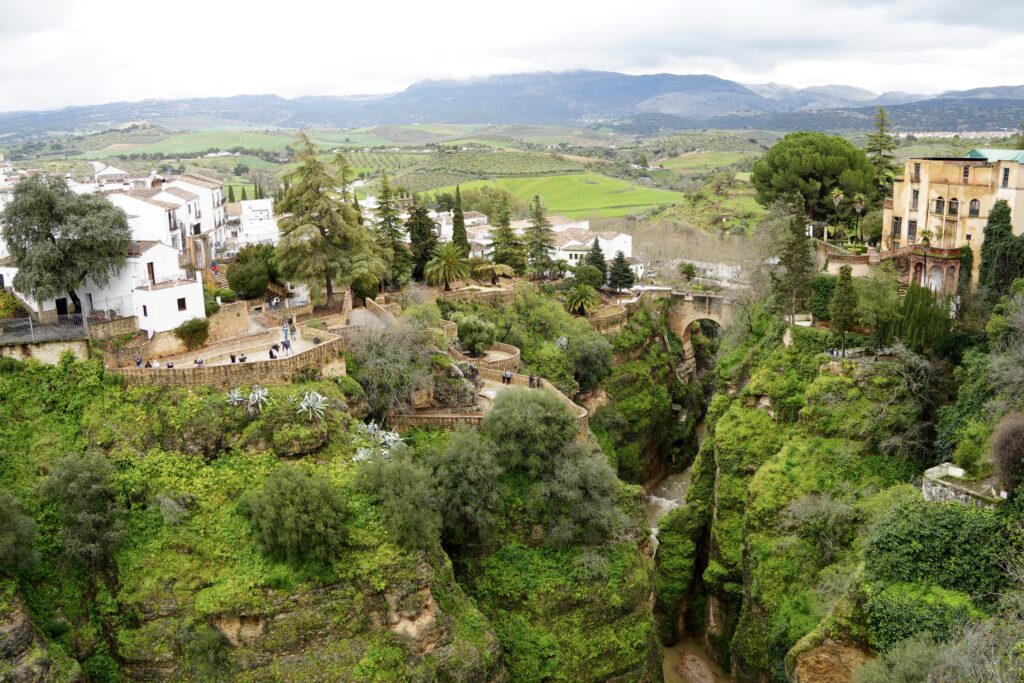
The Arab Bridge
The Arab Bridge is the oldest of the 3 bridges. It was built during the Muslim period and is near the Arab Baths.
The Arab Baths
The Arab baths are a thermal complex that was built during the Muslim period of the 13 and 14 centuries in Andalucia. Three bathing rooms are in the complex. Patrons would start in the hot room where steam would fill the air. They would then move on to the warm room and may even get a massage there. The cold room was last, and this is where an actual bath was located. The rooms have arched ceilings and star shaped skylights. We saw a few other Arab baths while in southern Spain but this was by far the most interesting. A movie plays on a constant loop in the farthest room of the baths depicting how the baths worked and portraying them in their prime.
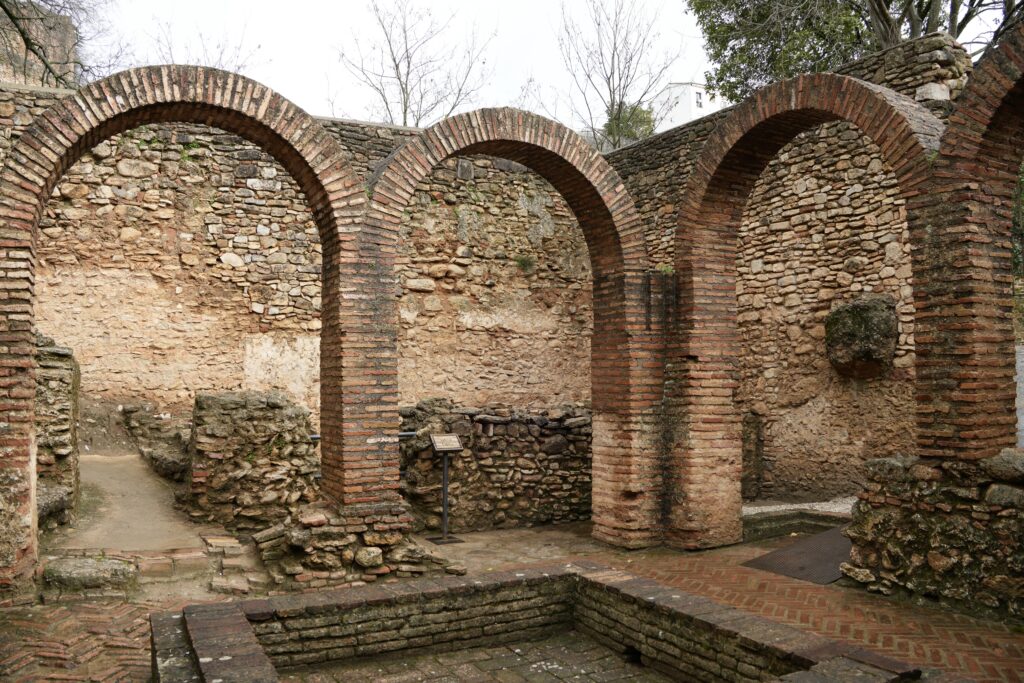
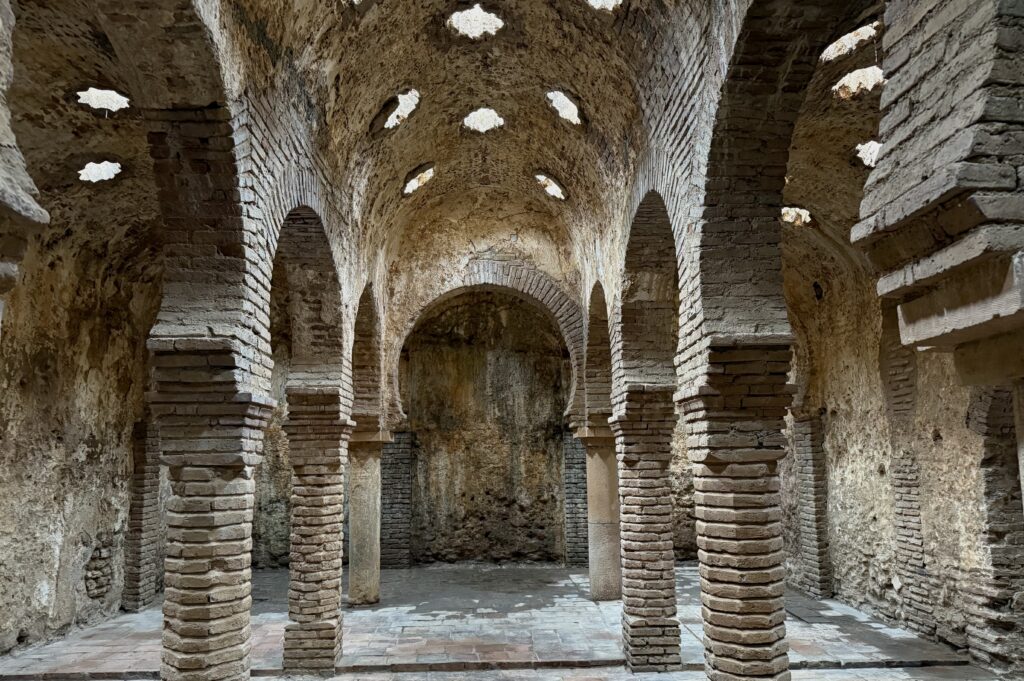
Córdoba
We really started to absorb the Muslim history of Andalucia while visiting Córdoba. We watched videos on the history of this time period starting with the Muslim entry into the region on 711 CE. We also learned about the Reconquista by the Christians and how they retook section by section. Diving deeper into the history on our own heightened the experience of visiting the Mosque-Cathedral and the archeological site of the Muslim Medina Azahara.
Mosque-Cathedral of Córdoba
The Mosque-Cathedral of Córdoba was one of my favorite sites in southern Spain. The building was built as a mosque in 785 by Abd al-Rahman I who was the founder of the Islamic Umayyad Emirate of Córdoba. The mosque was expanded a couple times until the end of the 10th century. The Christians conquered Córdoba and turned the mosque into a cathedral in 1236. Luckily for us visitors and all lovers of history, they chose to convert rather than destroy the mosque. Destruction was the fate of the other mosques throughout Andalucia. In the 16th century a new Renaissance nave and transept were constructed in the center of the building and the bell tower was updated.
The most recognizable characteristic of the Mosque-Cathedral is the endless rows of red and white two-tiered arches resting on columns. The design on these arches is created by alternating red bricks and white stone blocks. They cover most of the space except for the middle cathedral nave, the small chapels along the edges, and the mihrab (the alcove in the side wall of the mosque that indicated which direction to face to pray towards Mecca).

The mihrab is gorgeous and has a multitude of colors including blue, red, black, white, and gold in the designs. Quran prayers written in Arabic surround the arch. A stunning golden dome covered in plant motifs and criss-crossing ribs towers high above the mihrab.
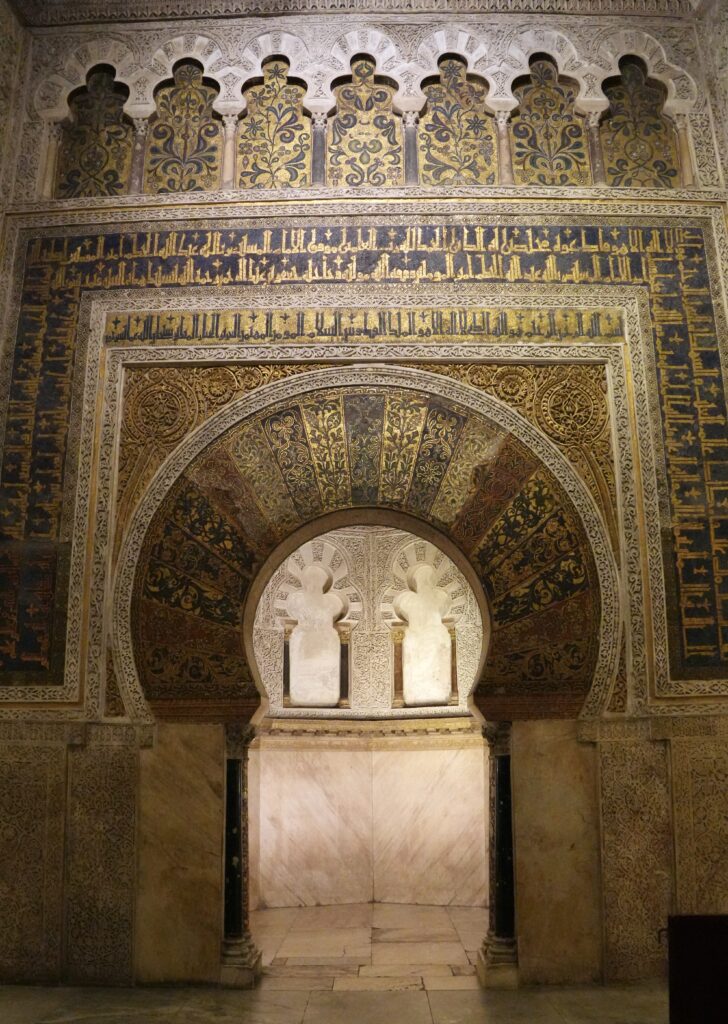
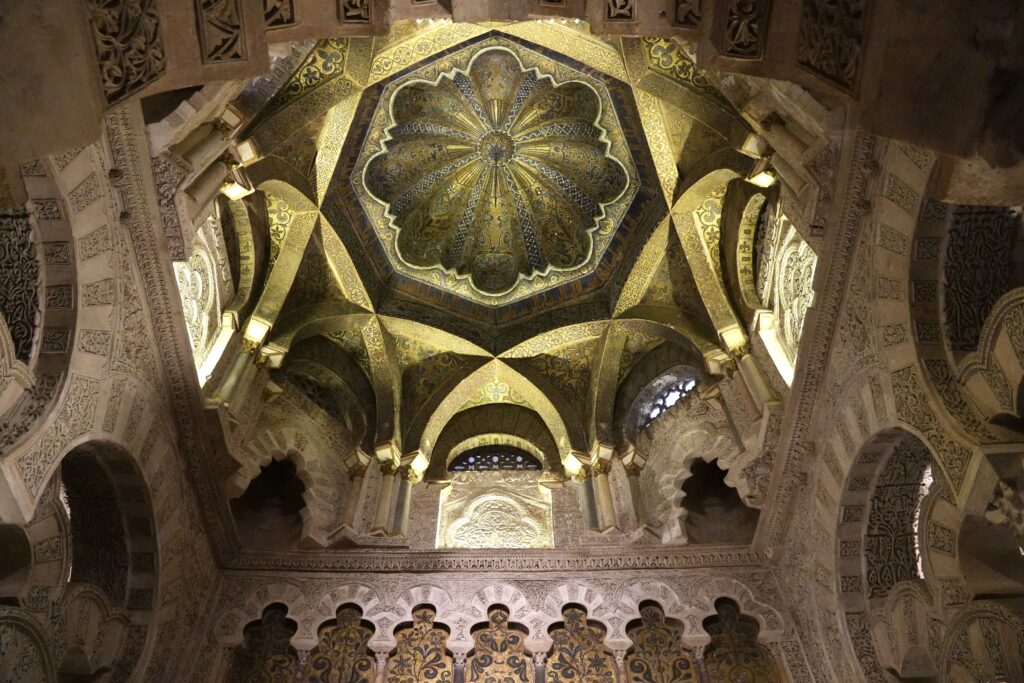
Spectacular polylobed arches and impressive domes are found throughout the prayer hall sections. Some of the columns inside are actually recycled Roman columns. The nave is set in the center of the building. It has high white ceilings with gold decor and a dome with arched windows letting light in to brighten the space.
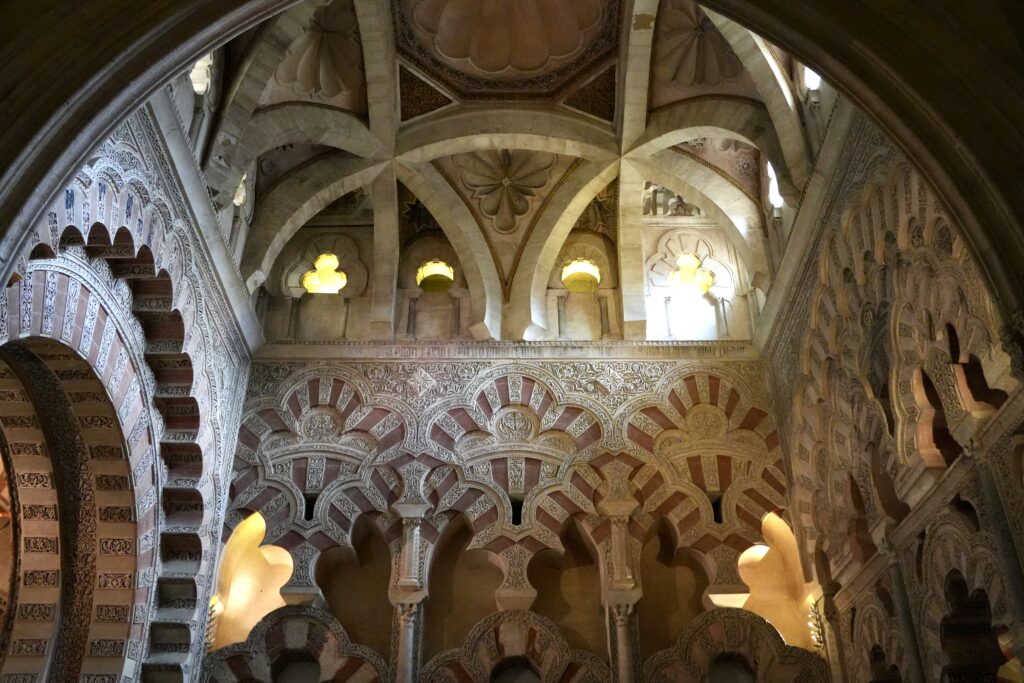
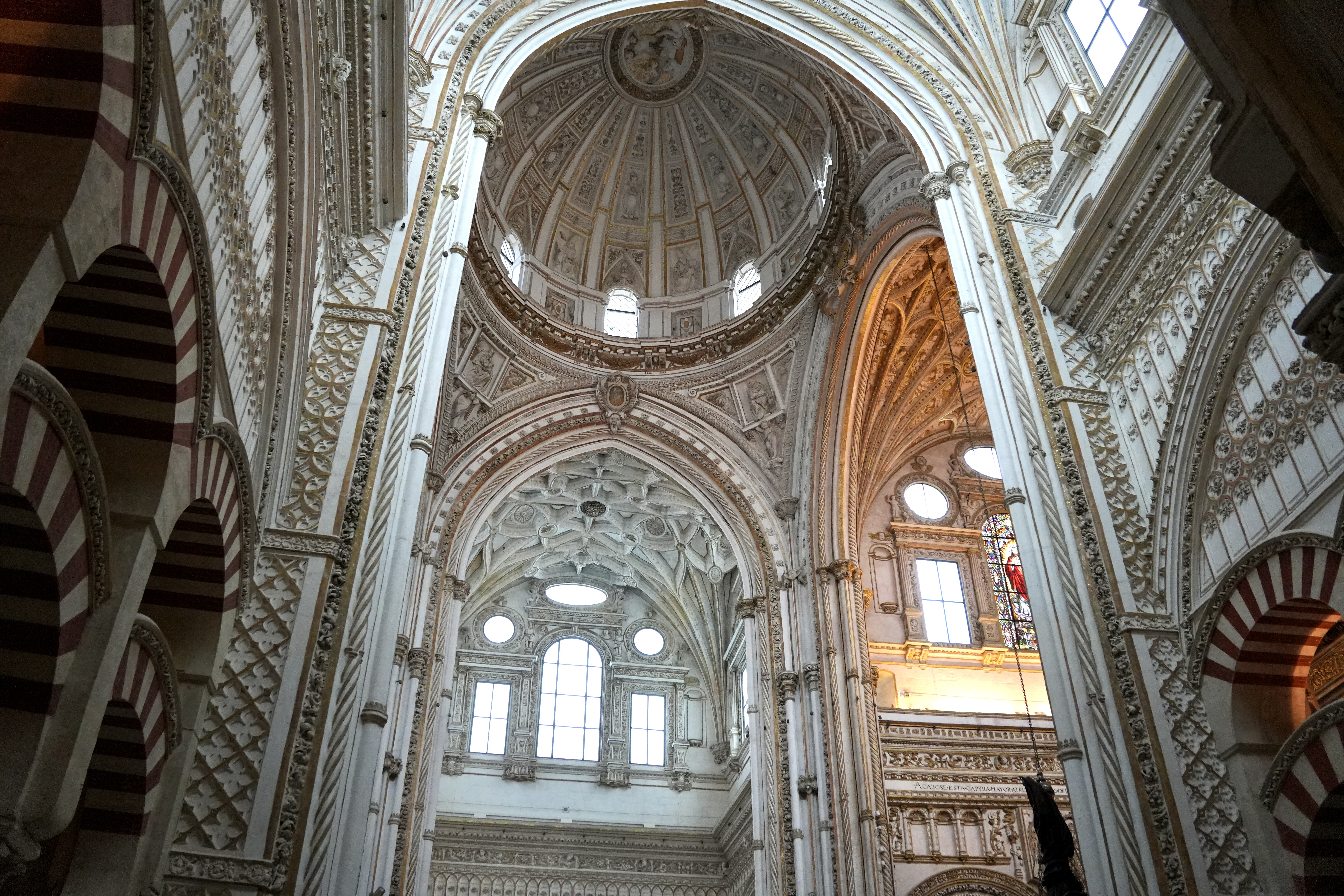
The outer walls also contain a courtyard with a large fountain. Muslims used the fountain to purify before entering the mosque. From this fountain, the Islamic architects designed an irrigation system. Water flows out and into a grid of narrow waterways that are used to irrigate the trees that fill the courtyard.
Tickets to visit the Mosque-Cathedral cost 13 euros per person starting at 10 am daily. However, the doors open at 8:30 am and entrance is free until 9:20 when visitors are ushered out. At 9:30 mass is held in the cathedral daily. After mass, the paid entrance begins. We felt there was enough time for us to see the site during the free hours but if you want more time inside, the paid entrance is available. We watched a video about the architecture which I strongly recommend: “Spain’s Architectural Wonder: The Great Mosque of Cordoba” by Manuel Bravo.
Alcázar de los Reyes Cristianos
Alcazar de los Reyes Cristianos or the “Castle of the Christian Monarchs” is a medieval castle that housed the monarchy. Honestly, I found this site underwhelming. There were some cool Roman mosaics inside, but they were unrelated to the history of the Alcazar. The gardens outside were nice, but I would recommend skipping this site. I did not find it worth the high cost to enter.
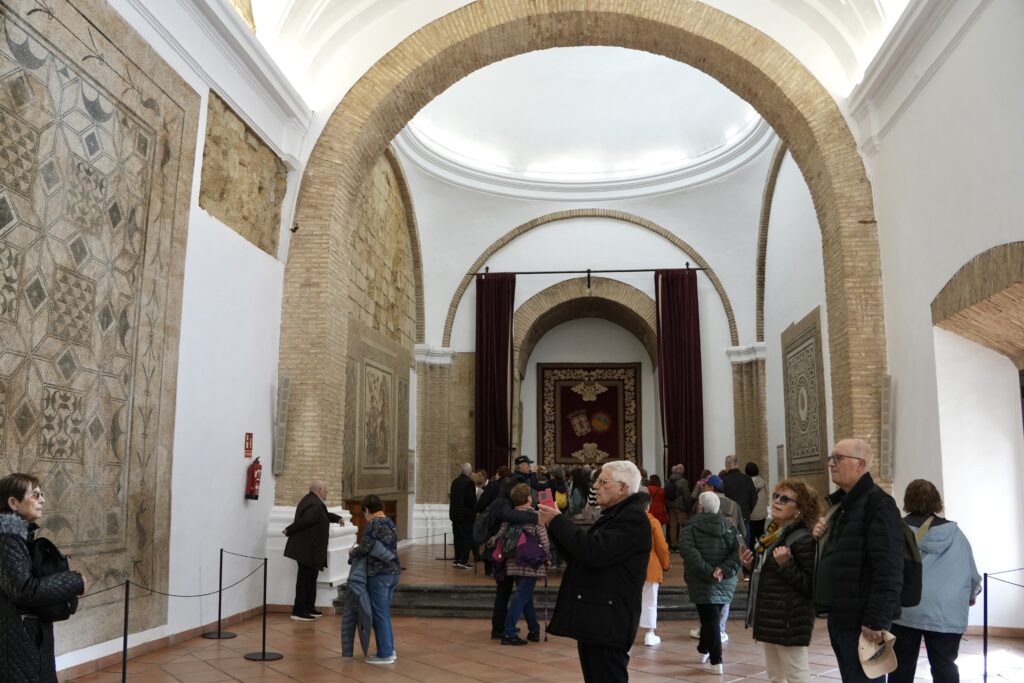
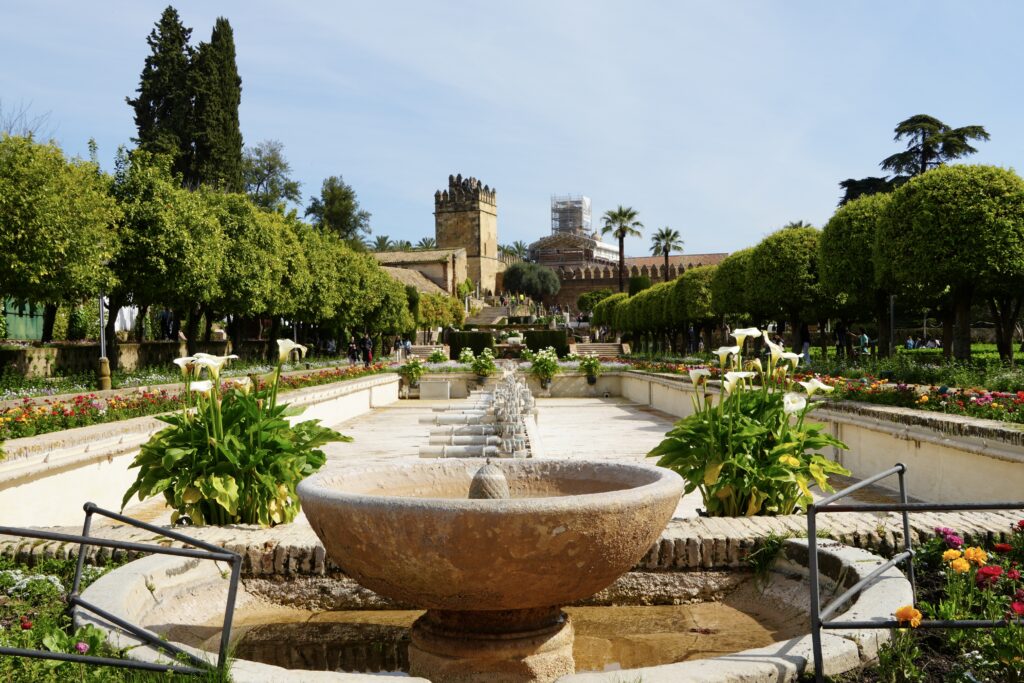
Roman Bridge
The Roman Bridge was originally built in the 1st century CE but has been reconstructed multiple times. Most of the bridge dates from the Arab reconstruction in the 8th century CE. It crosses the Guadalquivir River and leads to the Mosque-Cathedral. This pedestrian only bridge is free to walk across and the best view is from the southwest side of the river.
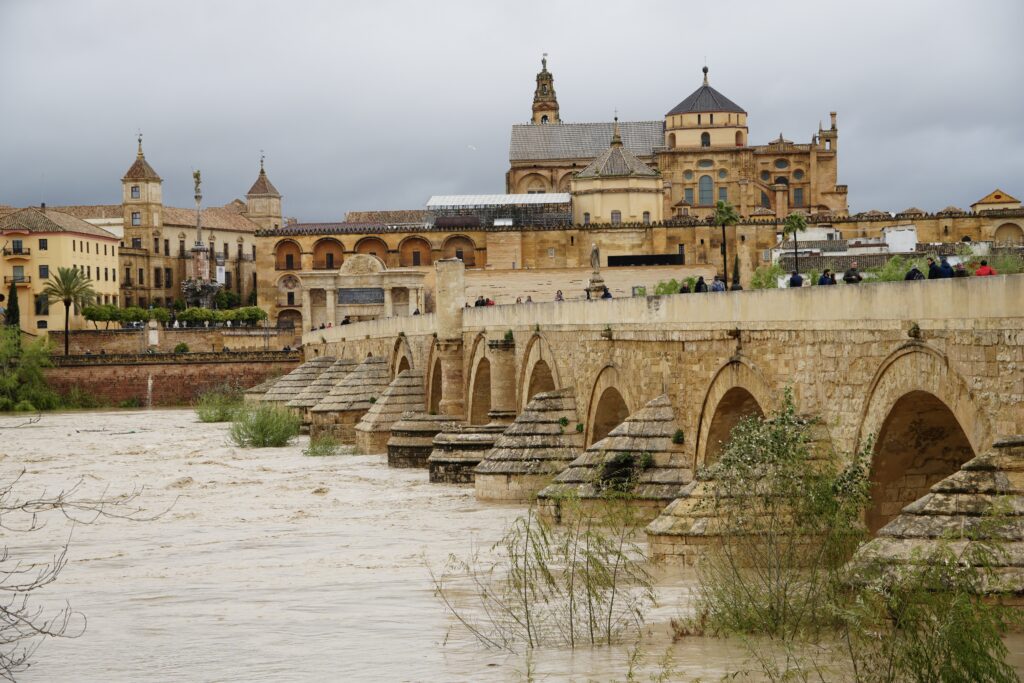
The Arab Baths (of Córdoba)
The Arab Baths in Cordoba were a major disappointment. Don’t waste your time on them. It was mostly just informational signs and a couple minor reconstructions. Even if you haven’t gotten to visit another Arab bath, I still would not bother visiting this one.
Medina Azahara
The archeological site of Medina Azahara was another highlight for us. Abd al-Rahman III decided to build this city-palace after proclaiming himself Caliph in 929 CE. It was built a short distance from Córdoba and was termed “The Shining City”. This city only lasted for about 70 years until it was destroyed during civil wars that overtook al-Andalus.
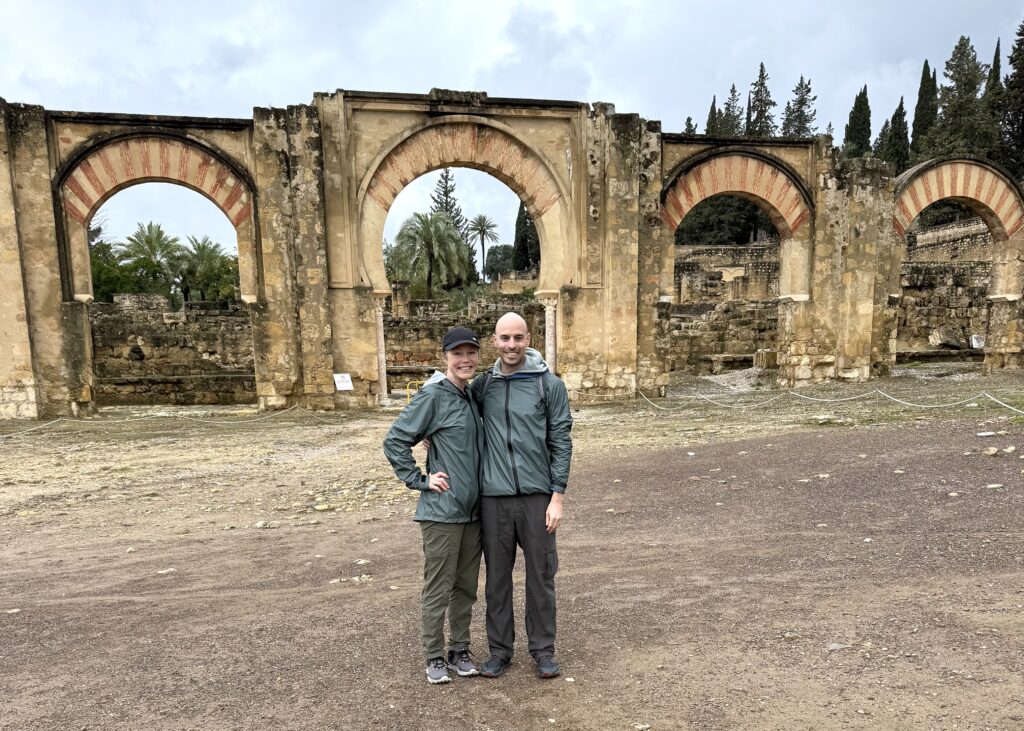
The area is an active archeological site with only about 10% of the area excavated. This means that the areas that will be available to be seen by tourists will be constantly changing. Hopefully even more will be reconstructed when you come to visit. Unfortunately for us, we didn’t get to see the reception hall of Ada al-Rahaman III, which I suspect is the most impressive section. The rest of the site was still very interesting and we were happy we made the effort to see it. We could still see the huge gardens that were in front of the blocked off reception hall from a distance. I especially loved the arches at the Eastern Gate, the Upper Basilica Hall, and the House of Ja’far.
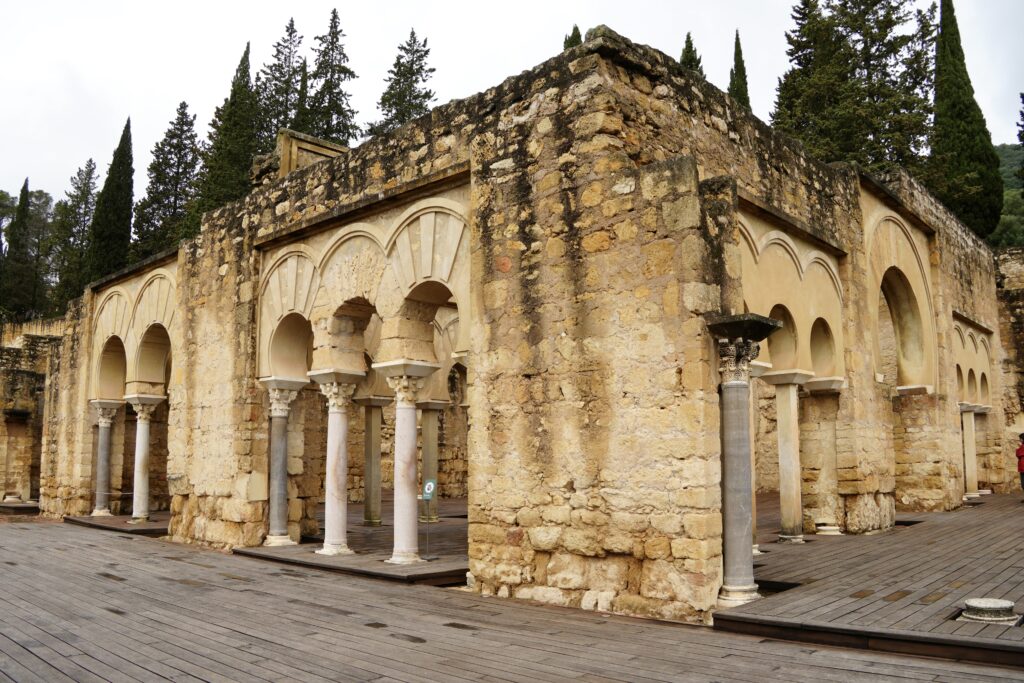
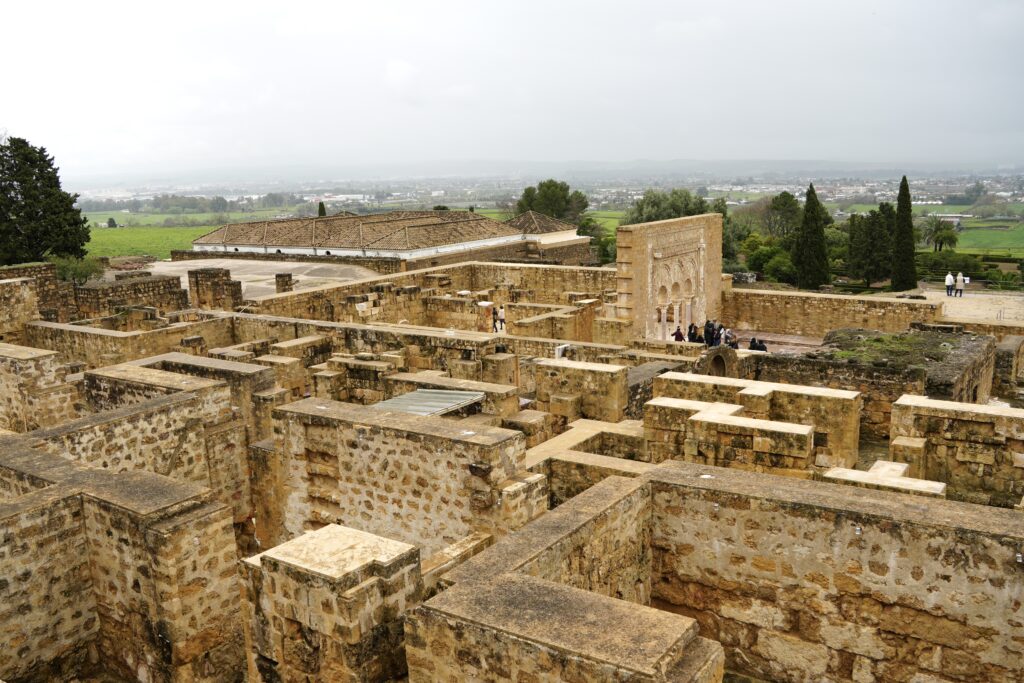
If you plan to visit the Medina Azahara, there are two videos I recommend watching prior. “Road Trip Spain and Portugal #037” is a great video for some information about the site and lots of advice for planning your visit. You can access it here: “Medina Azahara, the Shining City”.
This second recommendation is the video that the museum at Medina Azahara shows. The first video I shared recommends and links this video as well. You can watch it before going to Medina Azahara so that you can spend more time wandering the archeological site and seeing the items inside the museum. You can access it by clicking here: “Ven,conócela! Madinat al Zahra La Ciudad Brillante”.
Granada
Alhambra
The Alhambra was the last stronghold of the Moorish kingdom in Spain. This palace/fortress is one of the best preserved palaces and most famous examples of Islamic architecture. Construction of the complex began in 1238 by the founder of the Nasrid emirate of Granada. It was continuously modified and the most impressive characteristics of the palace were created in the 14th century. In 1492 when the reconquista pushed the last Nasrid emir out of Granada, the Christians took the Alhambra over. Charles V started construction of his own Renaissance style palace in 1526 within the grounds but it was left unfinished.
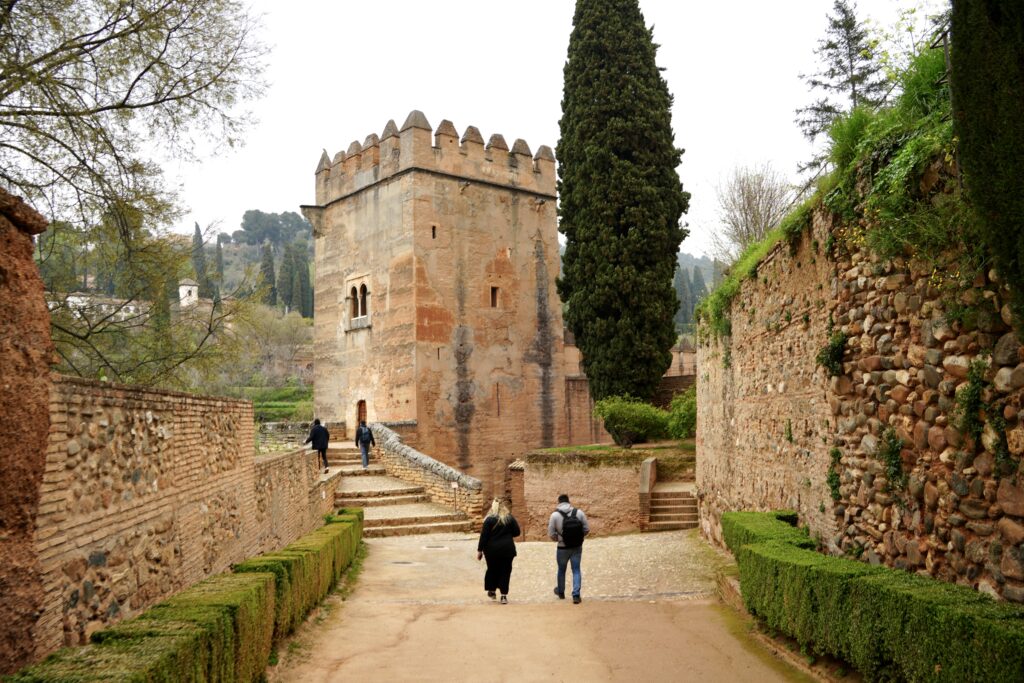
The Nasrid Palaces are the stars of the entire Alhambra. They were mostly built in the 14th century by the Muslim Nasrid emirate of Granada. Rooms throughout the palaces are decorated from ceiling to floor with carvings, latticed windows, and tiles. They have intricate decorations on the walls including repeating patterns and calligraphy of poems and verses from the Quran. Reflective pools and fountains rest in open air courtyards. These palaces were used by the Christian monarchy for a while after they conquered Granada, but then were abandoned. Reconstruction began in the 1800s but more seriously pursued in the 1900s.
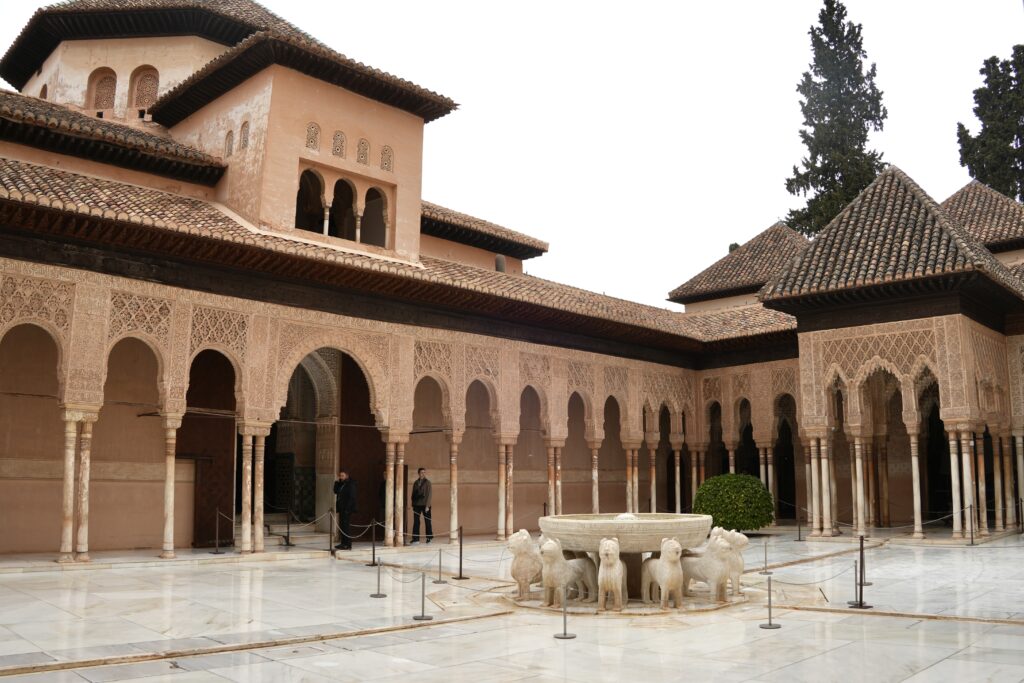
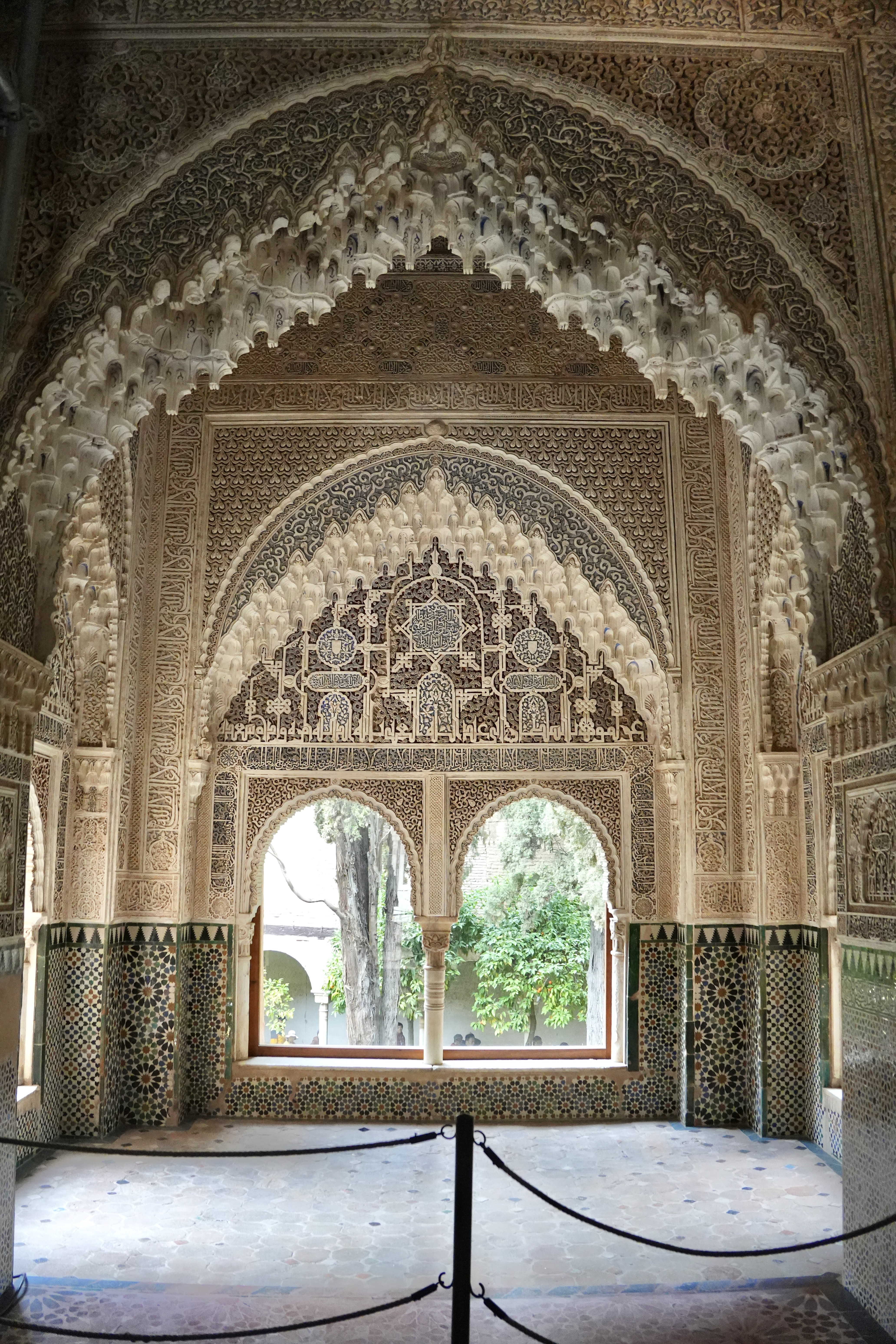
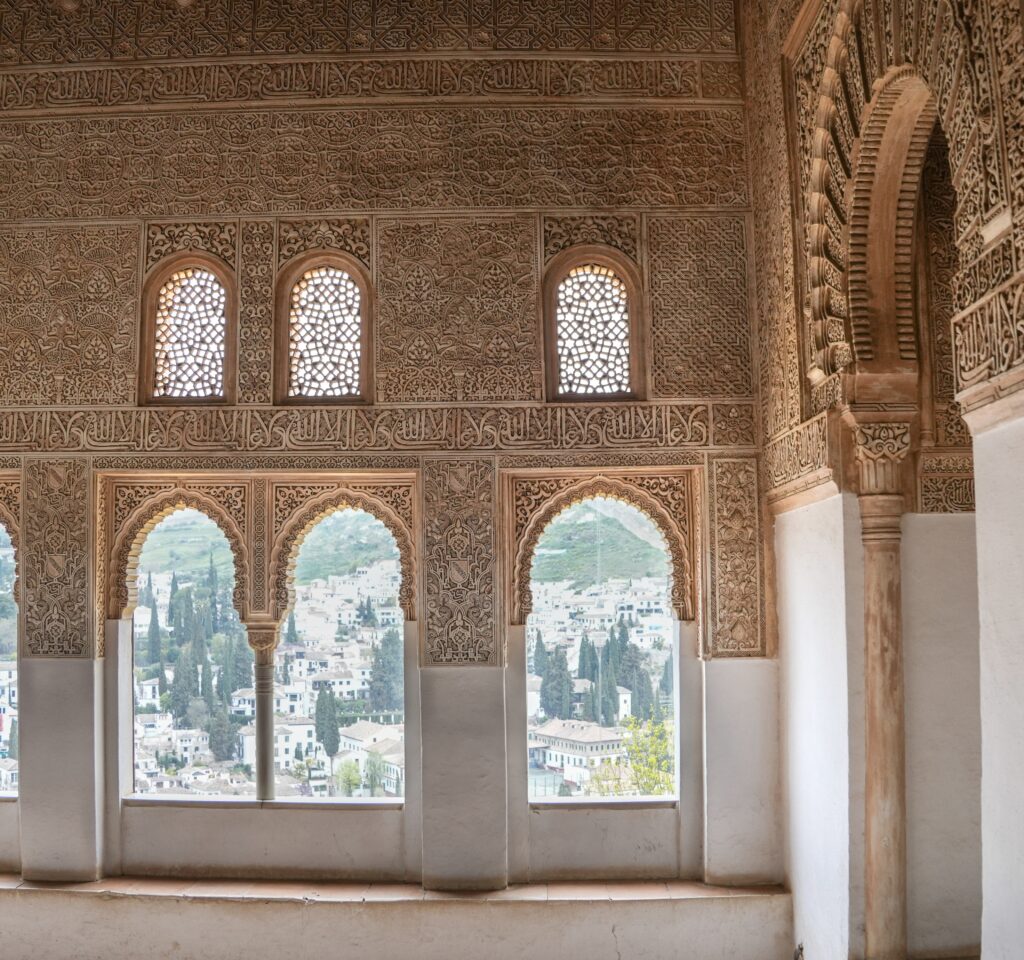
If you haven’t seen an Arab Bath in Spain yet, you can peer into a room of one while in the Nasrid Palaces. There is also another bath within the Alhambra that you can walk through that is nice. It doesn’t match the experience that Ronda’s bath provides, but is worth a walk through.
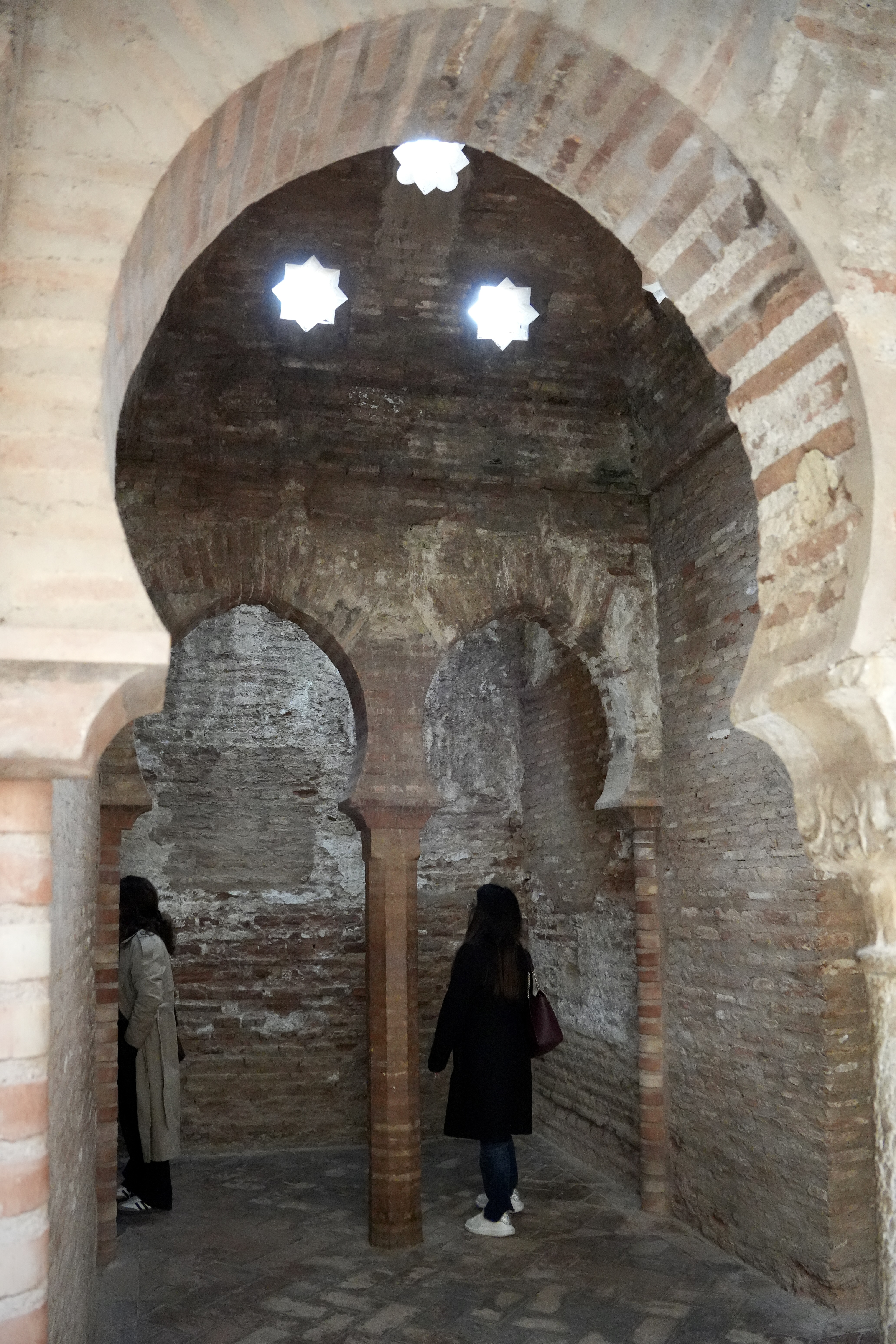
The Alcazaba is the oldest part of the Alhambra complex. It’s the remnants of a fort that once provided protection for a town of 2,000 Muslims who lived in the Alhambra grounds. Climbing up the towers provides great views over the city and other parts of the Alhambra.
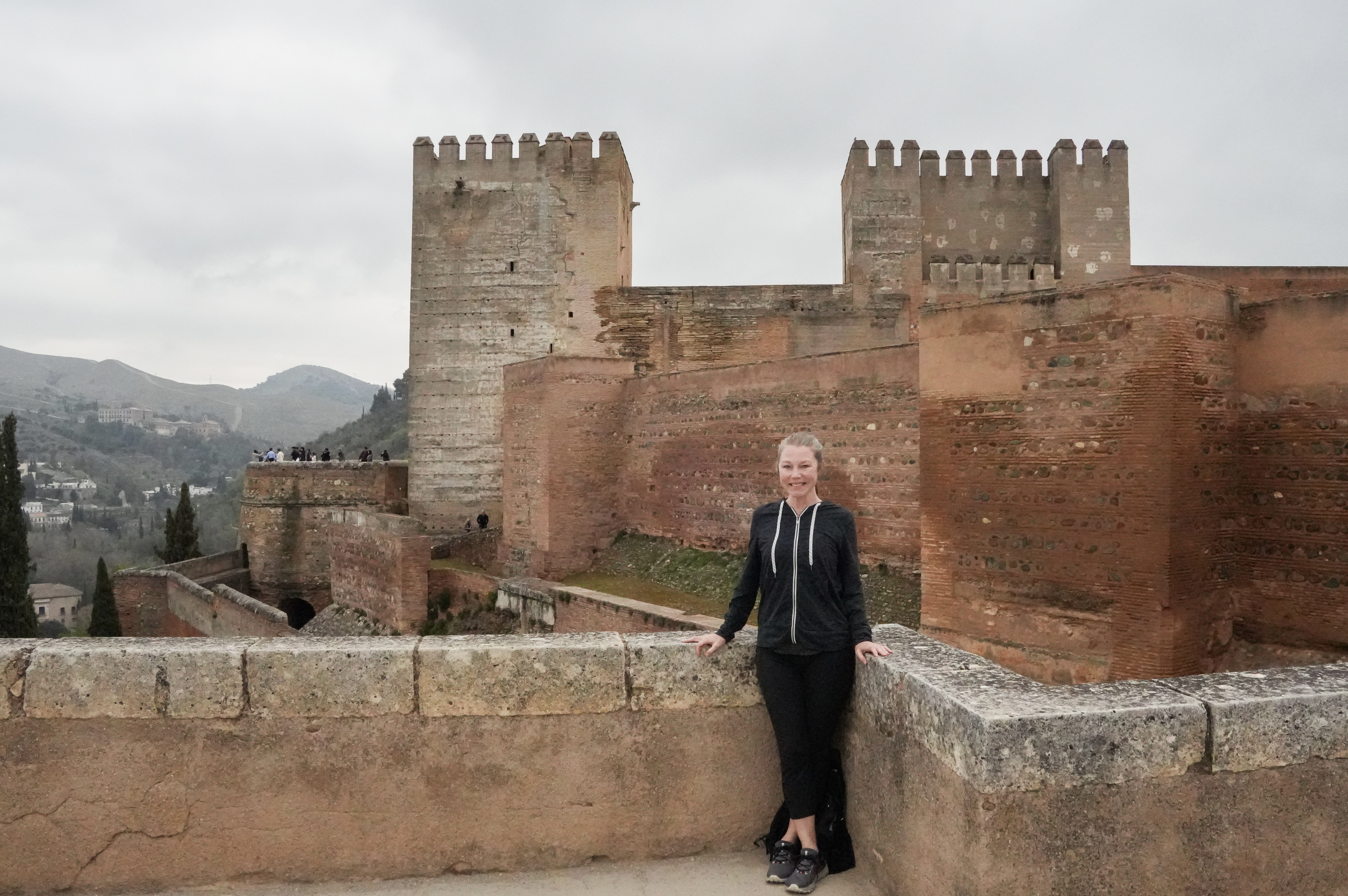
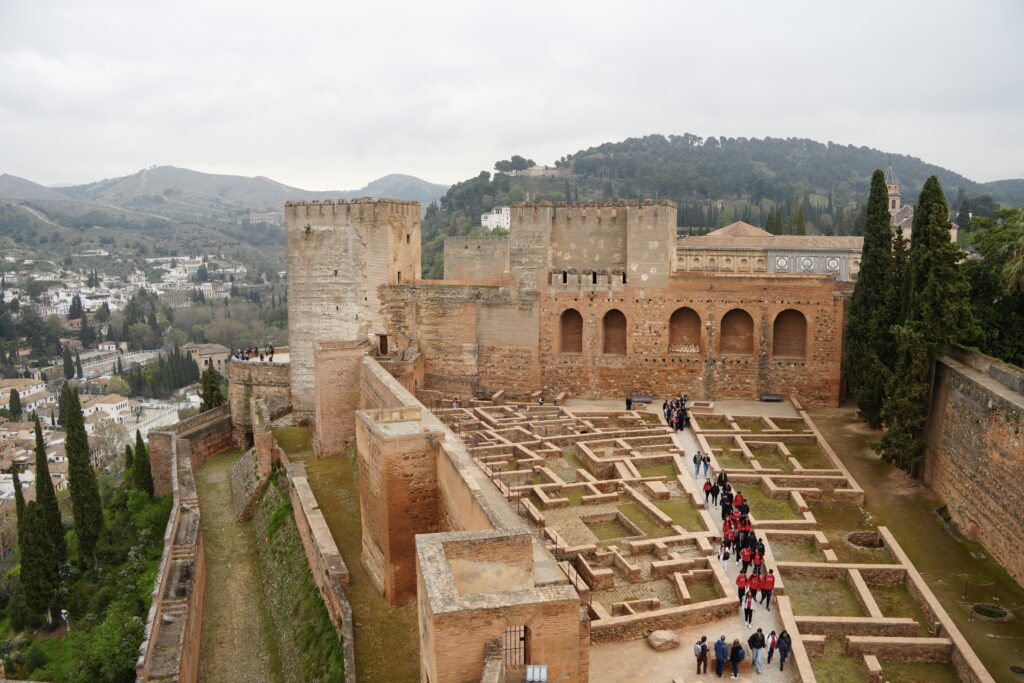
The Generalife is full of green plants and constant bubbling of flowing water. This area was outside the protective walls of the Alhambra, and the small palace here was used as a summer escape for the sultan. The sultan’s Summer Palace has some impressive decorations similar to the Nasrid Palace, though much less of it.
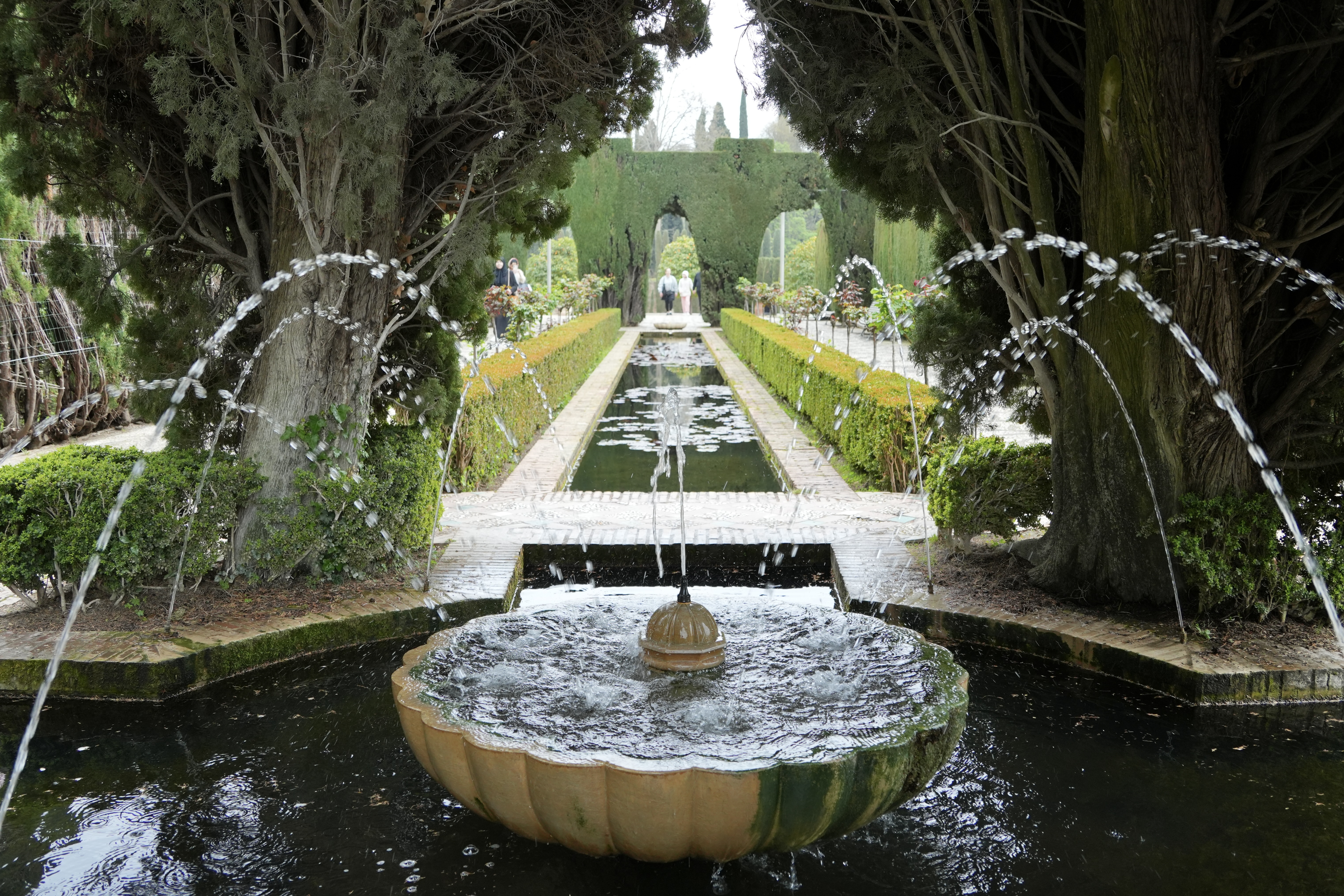
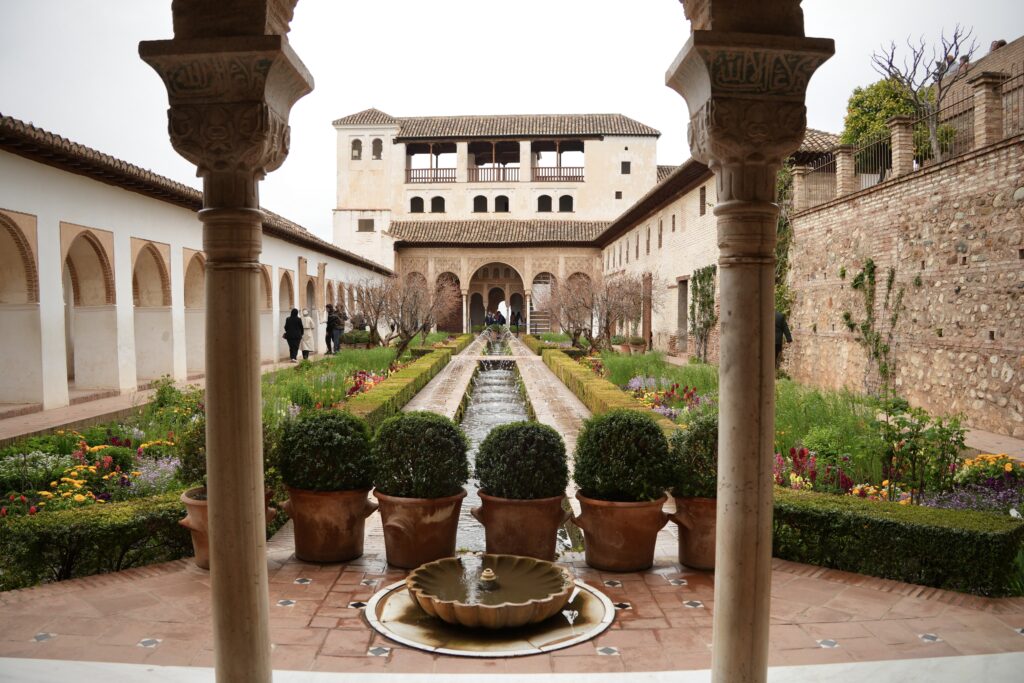
The Palace of Charles V is a Christian Renaissance palace built by Charles V. The two level building has a circular courtyard surrounded by columns. No ticket is required for this palace, it is free to enter. The Alhambra Museum (also free) is located on the south side on the ground floor of the Palace of Charles V.
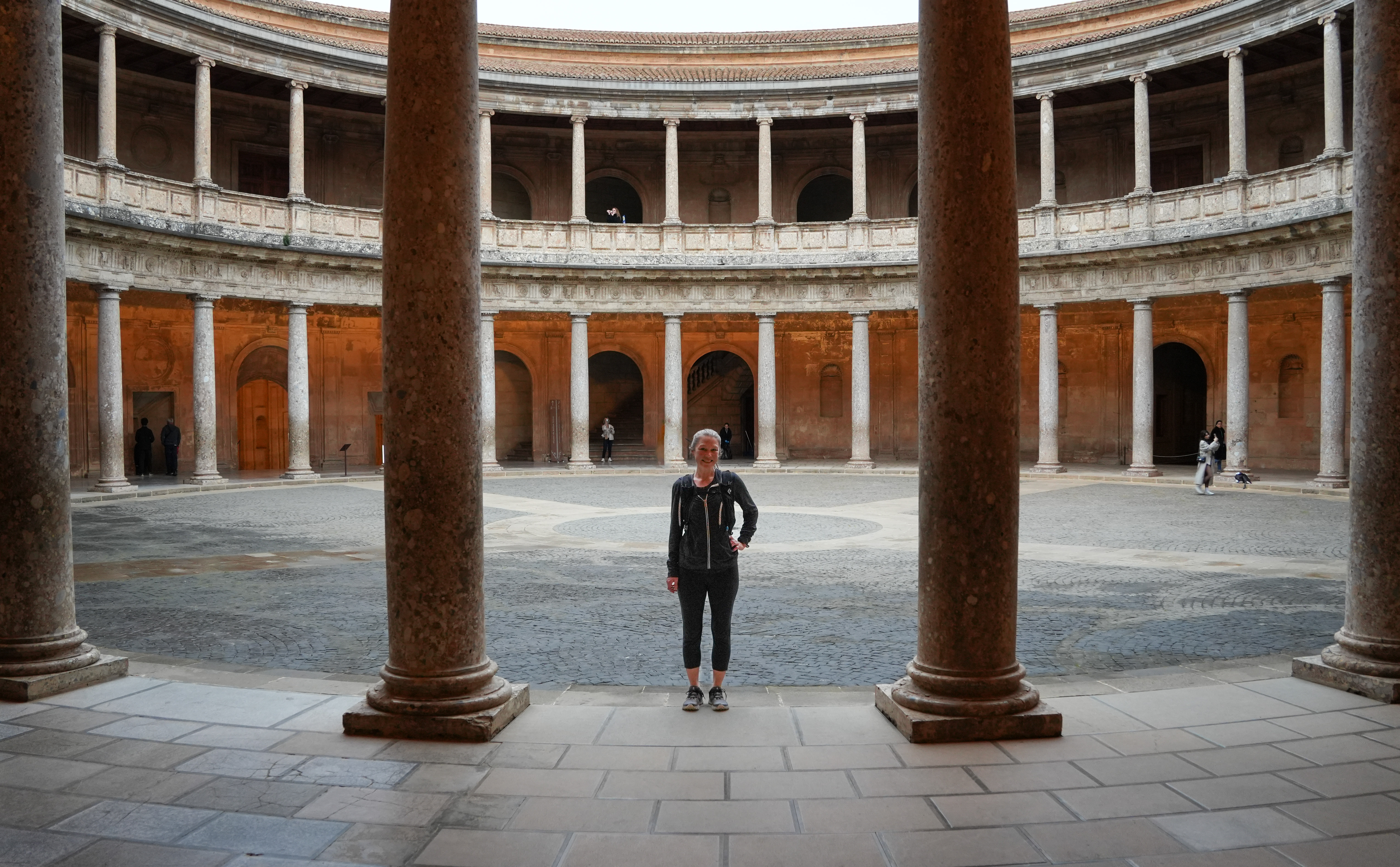
Be sure to get a ticket for the Alhambra well in advance. When we visited, they needed to be purchased about a month in advance in order to find an available ticket. I also recommend watching this YouTube video on the Alhambra by Manuel Bravo (same guy that made the video about Cordoba’s Mosque-Cathedral): “The Alhambra Explained”.
Granada Cathedral
The Granada Cathedral is the second largest cathedral in Spain. Construction began in the 1500s and wasn’t finished until the 1700s. The outer facade’s design was based on a triumphal arch, and knowing they built it over a destroyed mosque gives this more meaning. The interior is mostly renaissance style though its facade is baroque. It is technically connected to the Royal Chapel, though you must purchase a separate ticket and enter that from another door. The Royal Chapel houses the coffins of King Ferdinand and Queen Isabel.

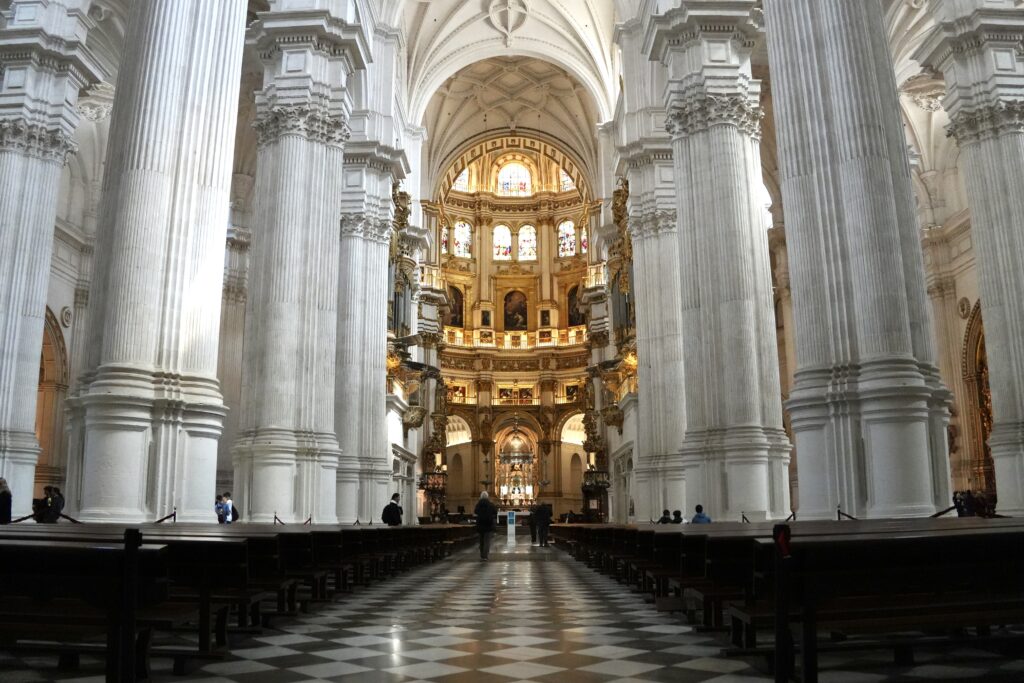
Basilica of Saint John of God (Basilica de San Juan de Dios)
The Basilica de San Juan de Dios will visually stun you. Gold, statues, and decorations cover almost every inch of this church. The ceilings are covered with murals depicting the heavens. This baroque basilica was built between 1737 and 1759. It holds the remains and personal items of Saint John of God.
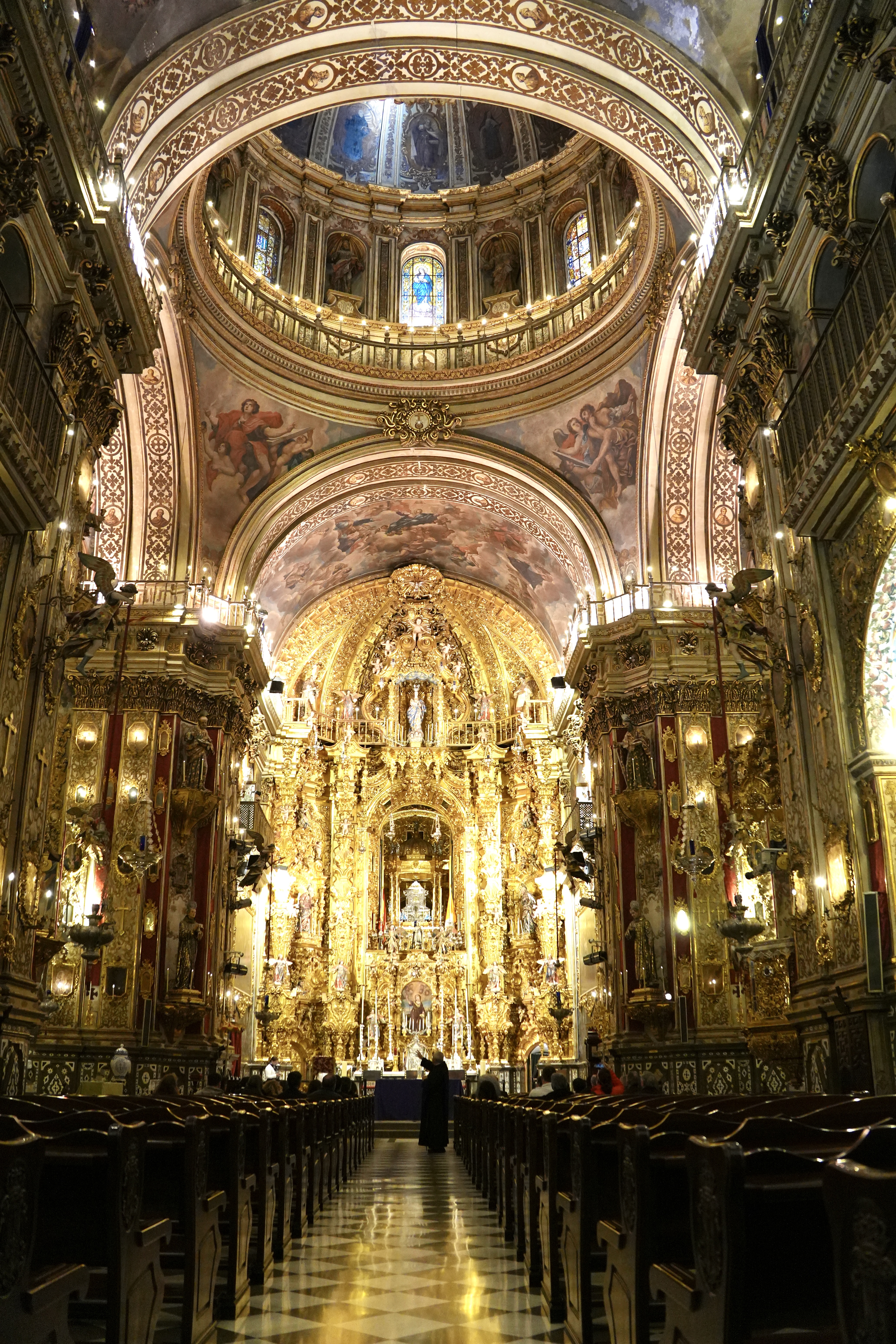
San Nicolas Viewpoint
The San Nicolas Viewpoint is one of the best views of the Alhambra and takes you into the whitewashed neighborhood of Albaicín. Albaicín has narrow roads retained from the Nasrid period between the 13th and 15th centuries.
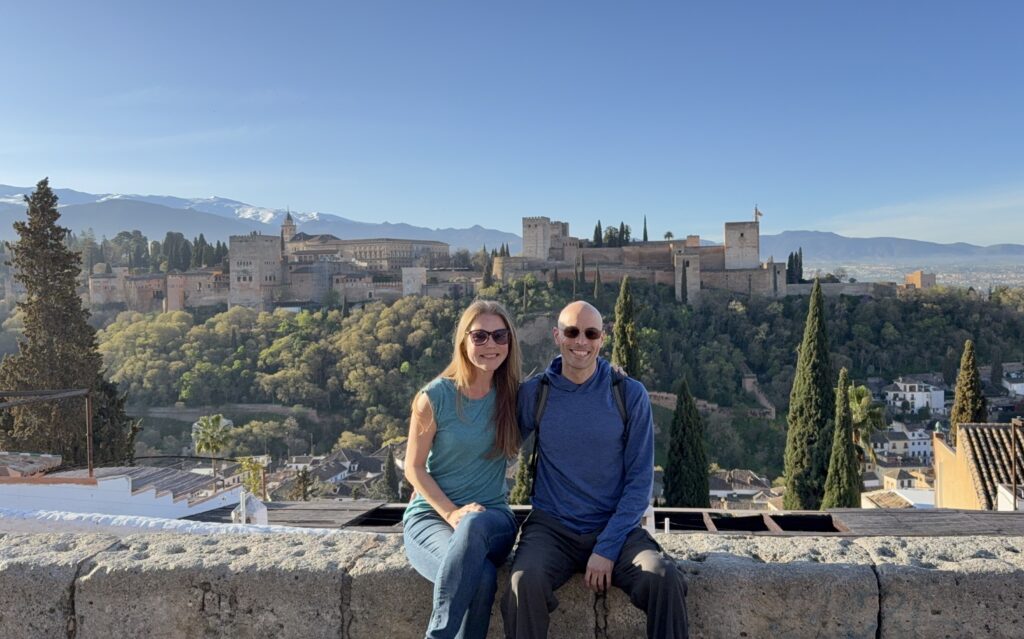
See a Flamenco Show
We went to a Flamenco show in a cave in the Sacromonte neighborhood. The cave setting was an intimate atmosphere to watch and listen to the performance. The Sacromonte neighborhood was settled by Romani people that came to Granada after the Christian reconquista in the 15th century. The Roma people are credited with developing the unique style of flamenco performed in Andalusia.
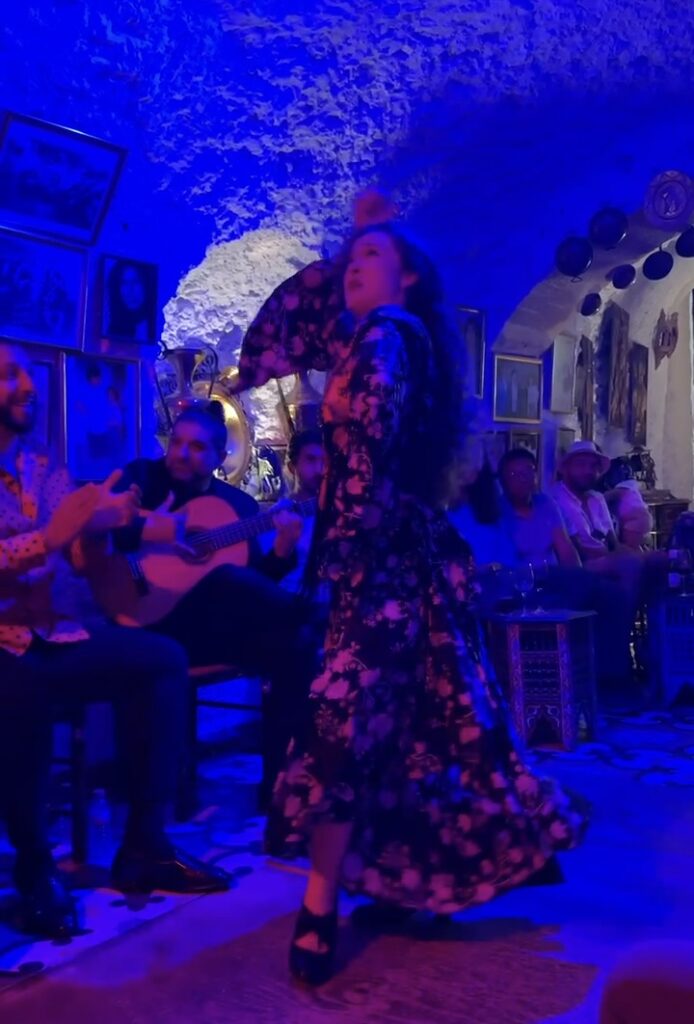
Sierra Nevada Mountains
The Sierra Nevada Mountains are near Granada and can even be seen from the city. To get some nice views of the mountains without needing to arrange transport, it just takes a bit of exercise. There is a hike from the Alhambra up into the park in the hills above that has nice views and a chance to walk in nature.
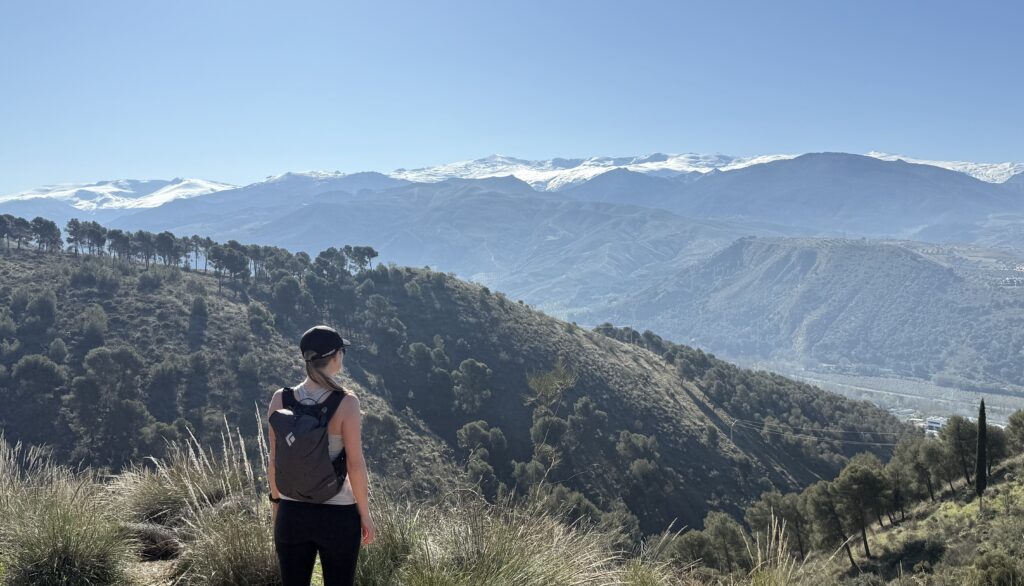
We also went on a short hike in Los Cahorros which is located on the edge of the town of Monachil. This is a town close to Granada that you could take a bus or taxi to reach. The hike has fun hanging bridges to cross before walking along a narrow trail along the stone walls of the mountains. In some areas you will need to crawl under sections of stone to pass through. Soon it opens up to see mountains surrounding you. We were hiking with friends with a young child, so we didn’t get further than a couple miles into the hike. On our return, the bridges were backed up with tourists. If you hike in this area, you should go early in the morning to beat the crowds.
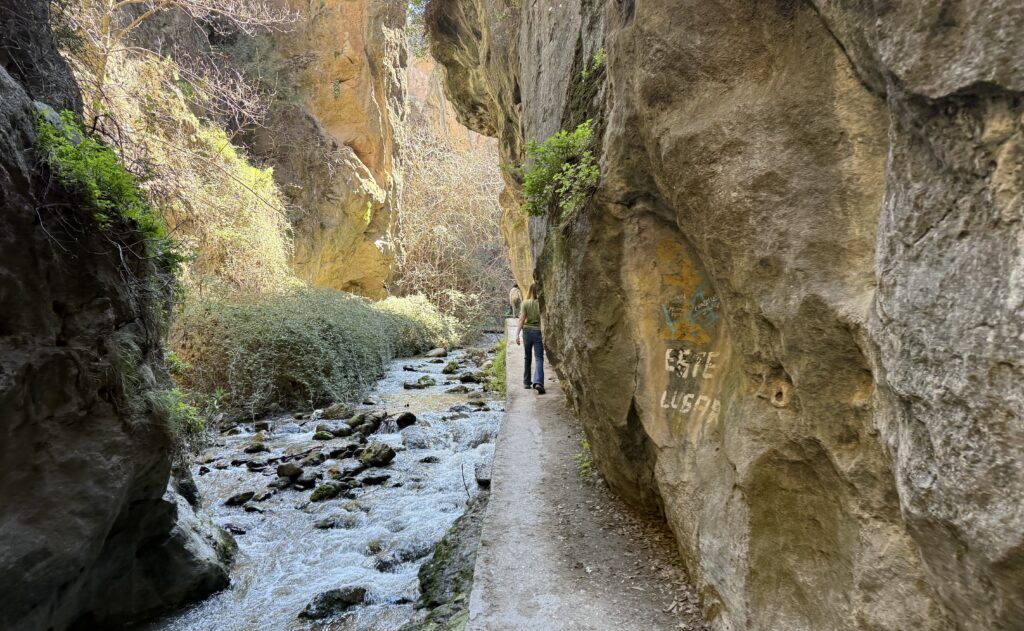
Seville
Seville was a great place to end our visit. Nearby is the famous Roman city of Italica which is the most exciting of the Roman ruins we saw during our Andalucia trip. We saw a palace that has been in use since Muslim times and has over the top decor that can wow you even after seeing the Alhambra.
Torre del Oro
The Torre del Oro is the “Gold Tower” which was used by the Muslims to defend the city. They had a chain that they draped across the river that would destroy boats that tried to invade. This was very effective until Ferdinand III managed to take the city in 1248.
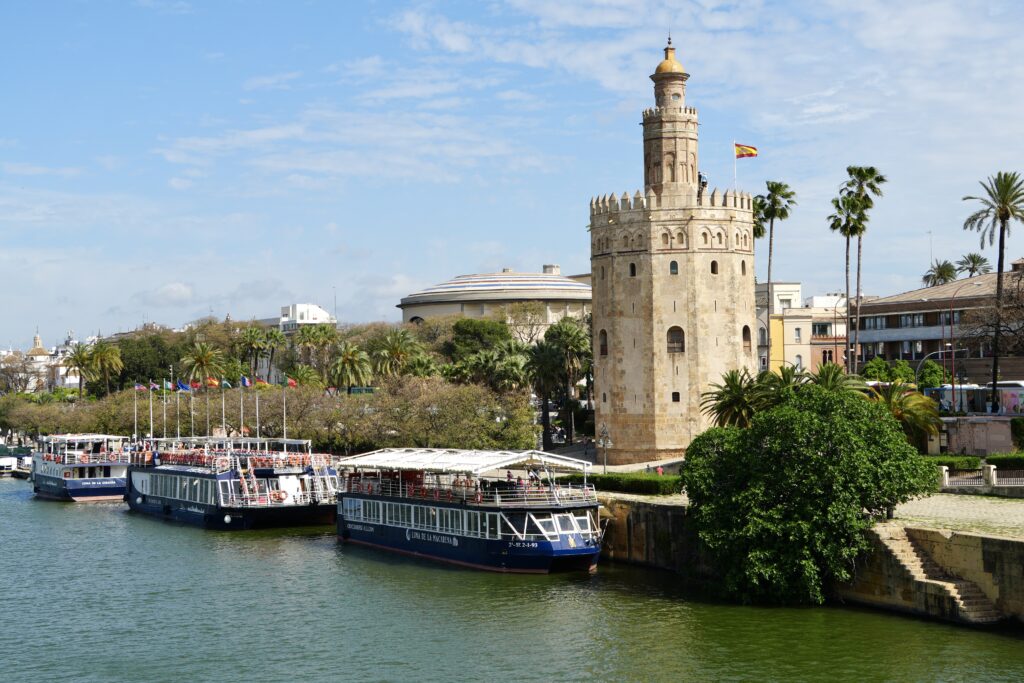
Royal Alcazar
The Royal Alcazar in Seville is one of the top sites in the city. This royal palace has been in use since the 10th century by the Muslim rulers at that time. Then it was used by the Christian monarchy once they took over.
The Royal Alcazar is really impressive. The entire grounds are surrounded by protective walls. Within these walls is a maze of a palace and enormous gardens that I got lost in. The most stunning parts of the palace are the areas that were designed in the Moorish style. The Christian king hired a Moorish architect to design the palace in the Moorish style and it is really incredible. Much of the incredible ornamentation that we saw in the Alhambra’s Nasrid Palace was also present in this design. Since this palace has always been in use it is in better condition than the Alhambra is and the colors in the decorations are stunning. There is even Arabic writing incorporated in the designs even though the rulers it was built for were Catholic. The palace has some renaissance rooms as well with towering ceilings and walls covered in impressive tapestries.
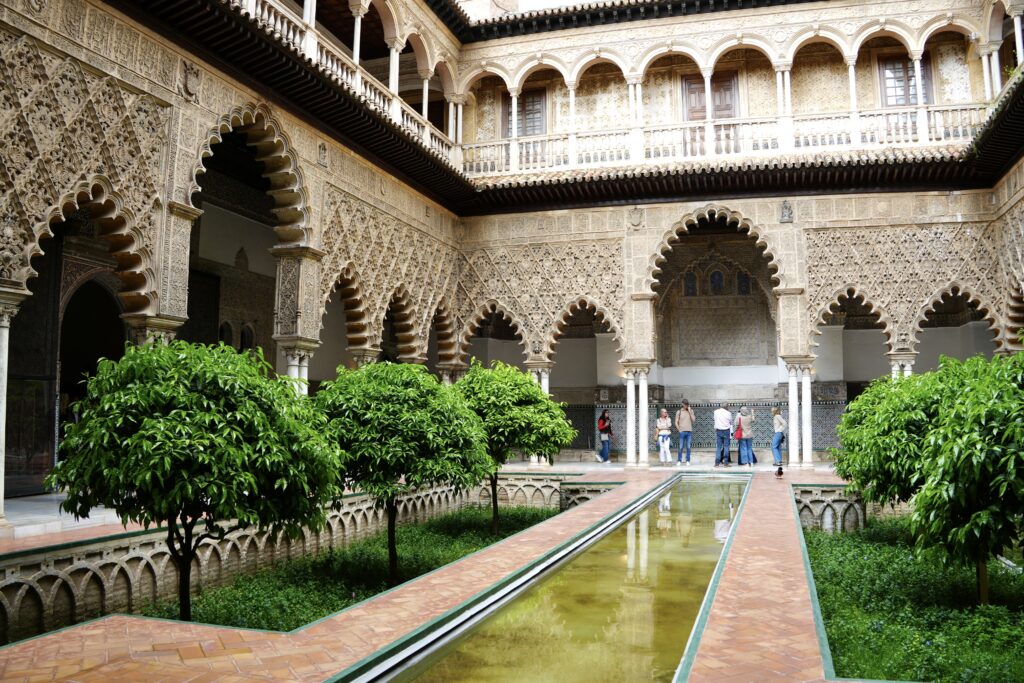
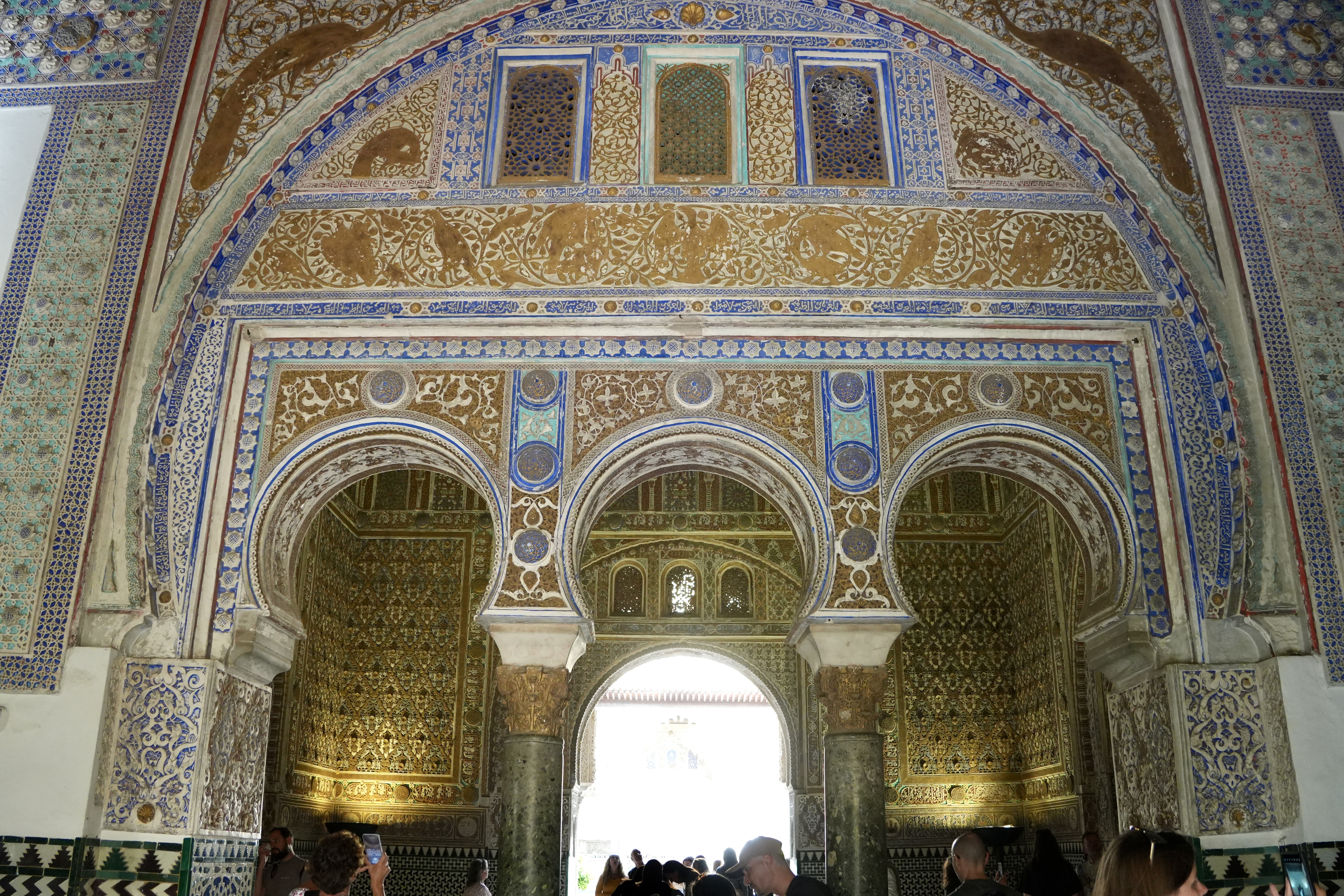
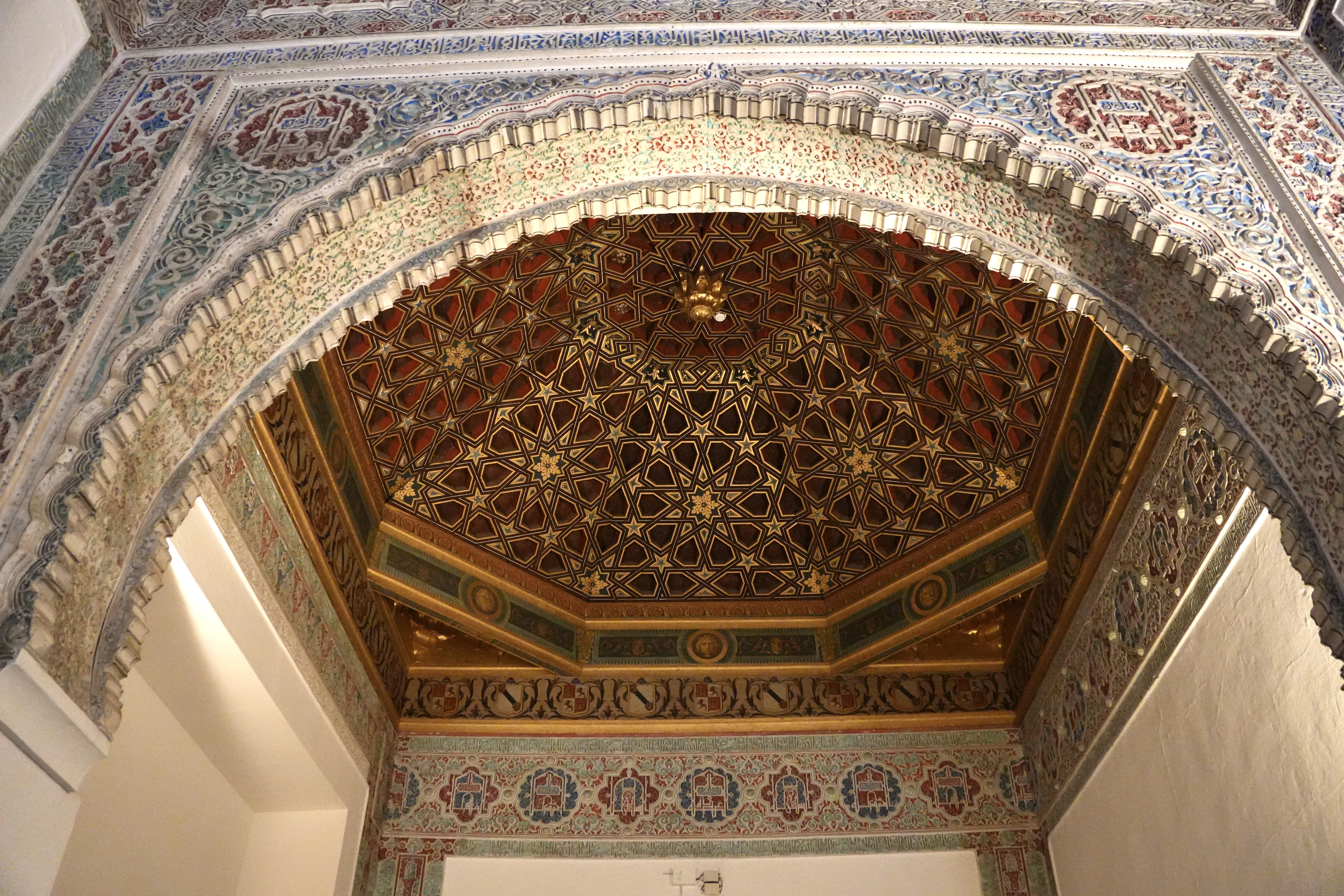
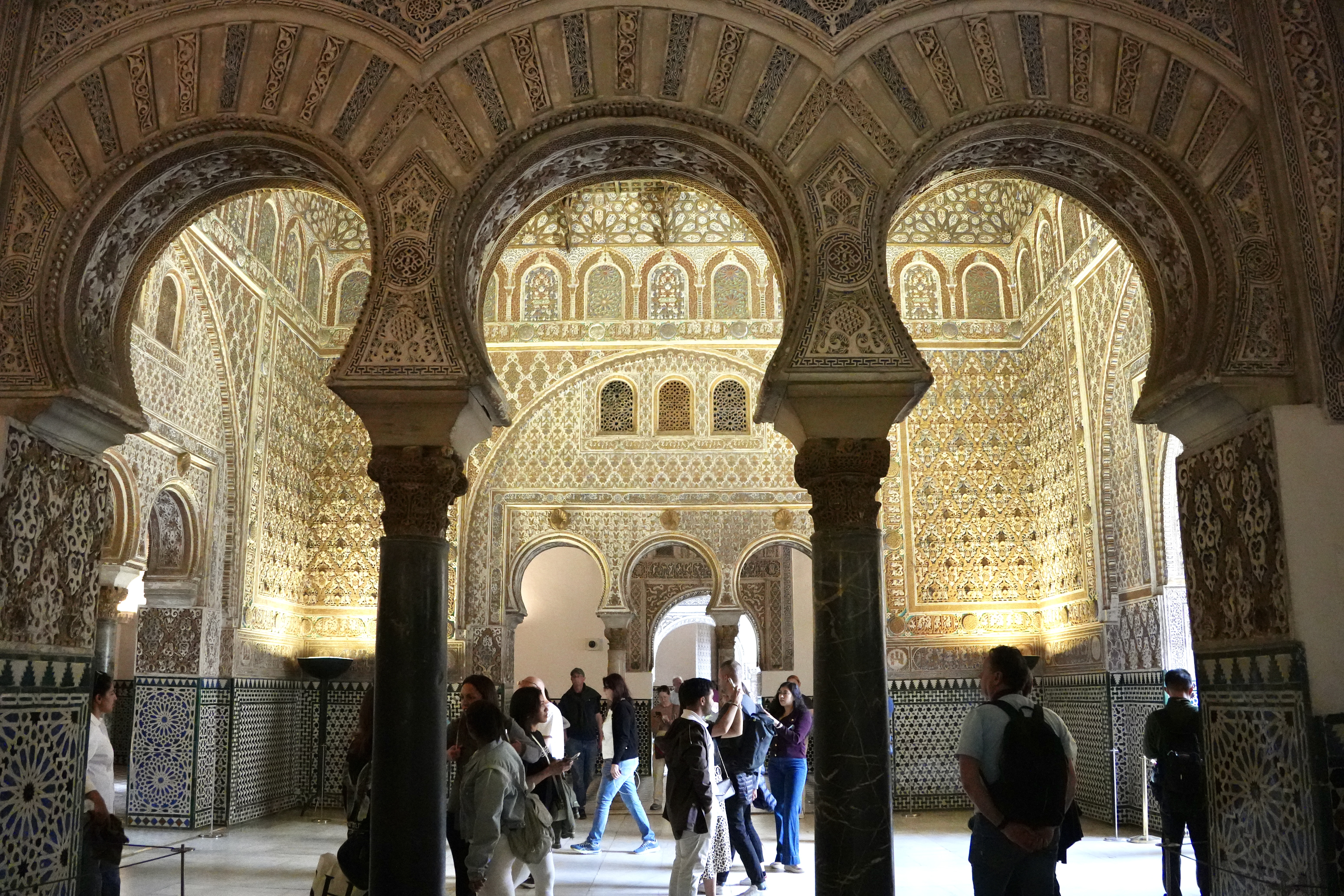
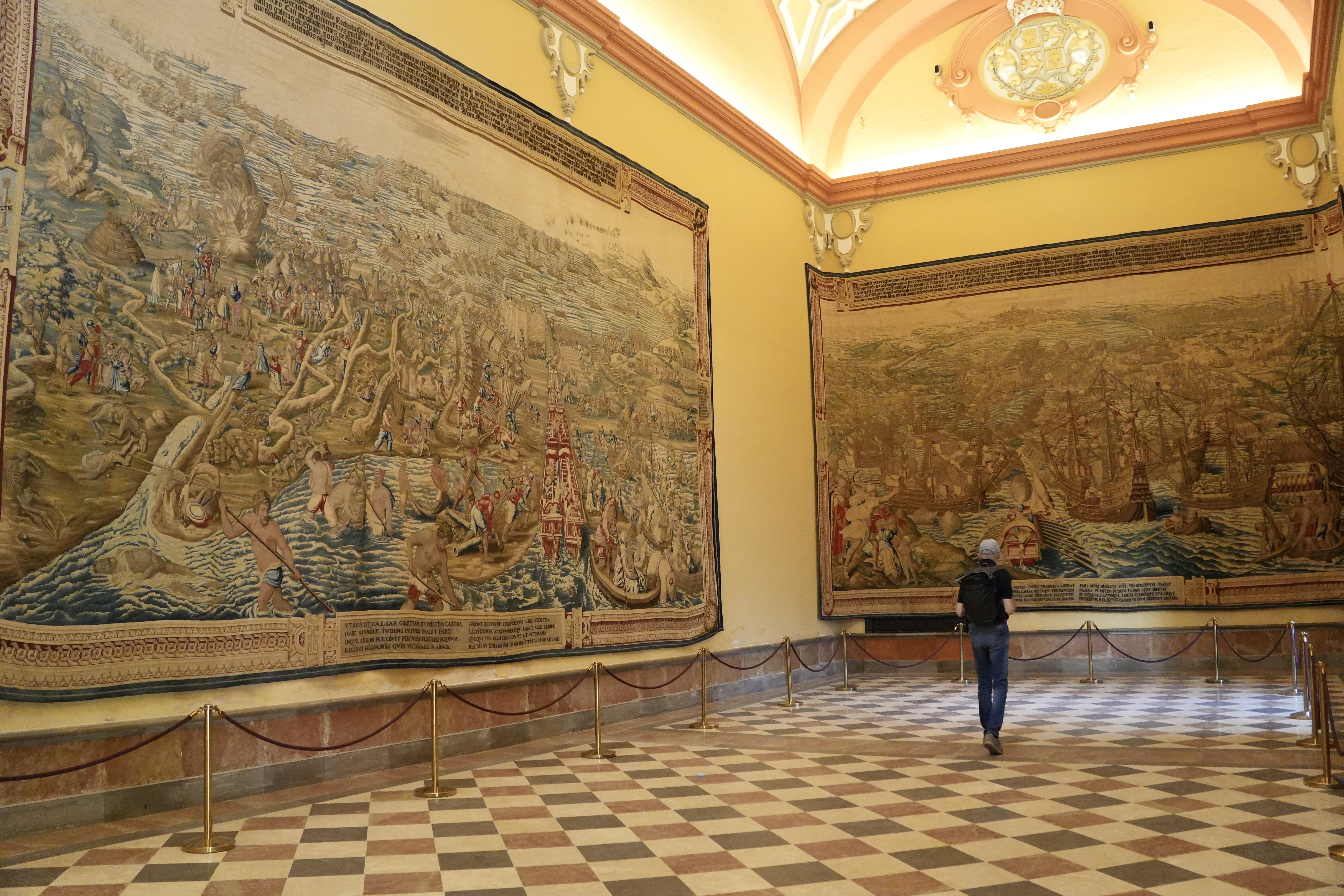
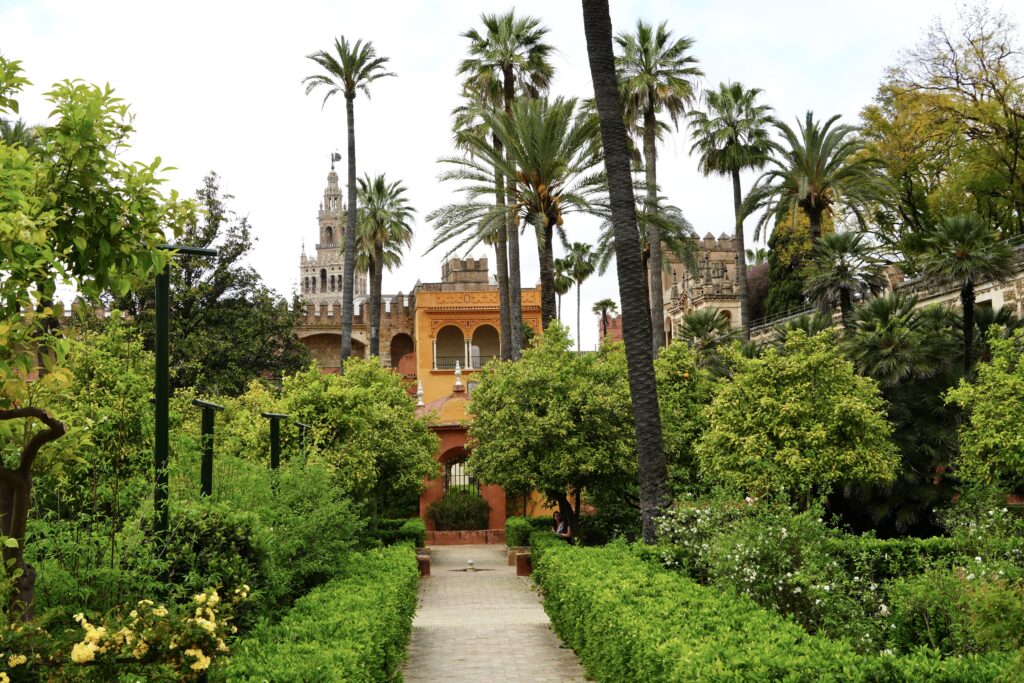
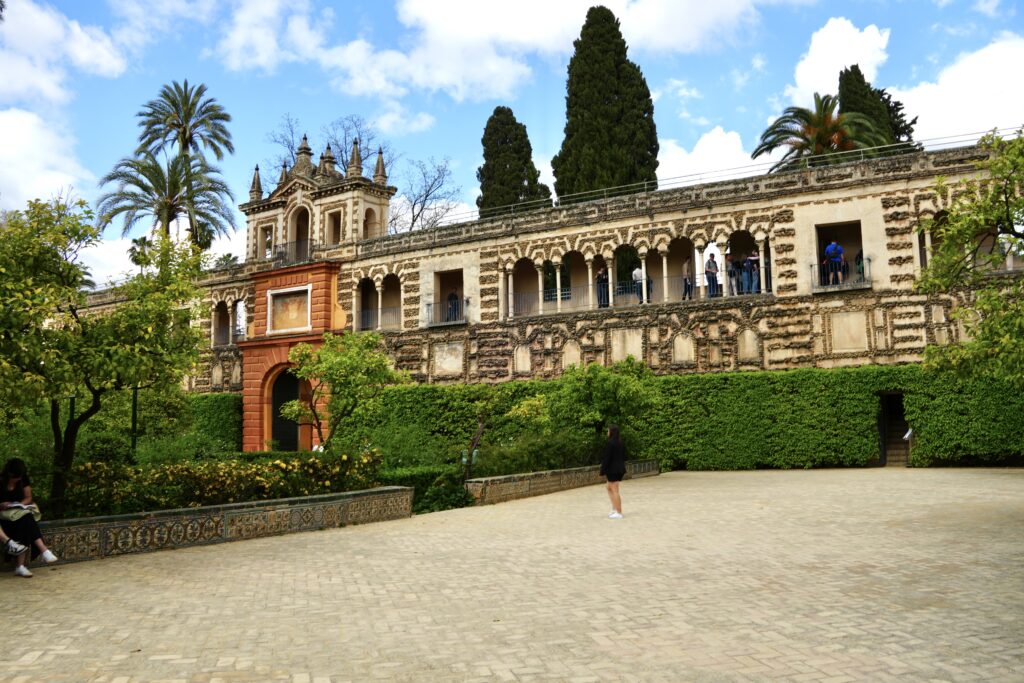
Italica
Italica is the active archeological site of the Roman city of Italica. Most of the buildings are yet to be excavated and restored, but the site is still impressive and will be increasingly so in the future. Italica is located just 7 km from Seville and you can easily take a bus to visit it.
Italica was founded in 206 BCE as the first Roman settlement in Spain. It was built along the Guadalquivir River. The well-known emperors Trajan and Hadrian were both born in Italica. The city had a forum, a temple dedicated to Trajan, baths, an athletic training space, as well as mansions, homes, and bakeries. The city began to diminish in the 3rd century CE.
Many parts of Italica were not built over, as often happened with ancient cities, though the current city of Santiponce does cover parts of it. Therefore, many of the structures were well preserved. However, the remains of this city were continually looted and destroyed for materials through the 18th century. Even in the 19th century, some mosaic floors were taken by the Countess of Lebrija for her personal collection. More on that in the next site.
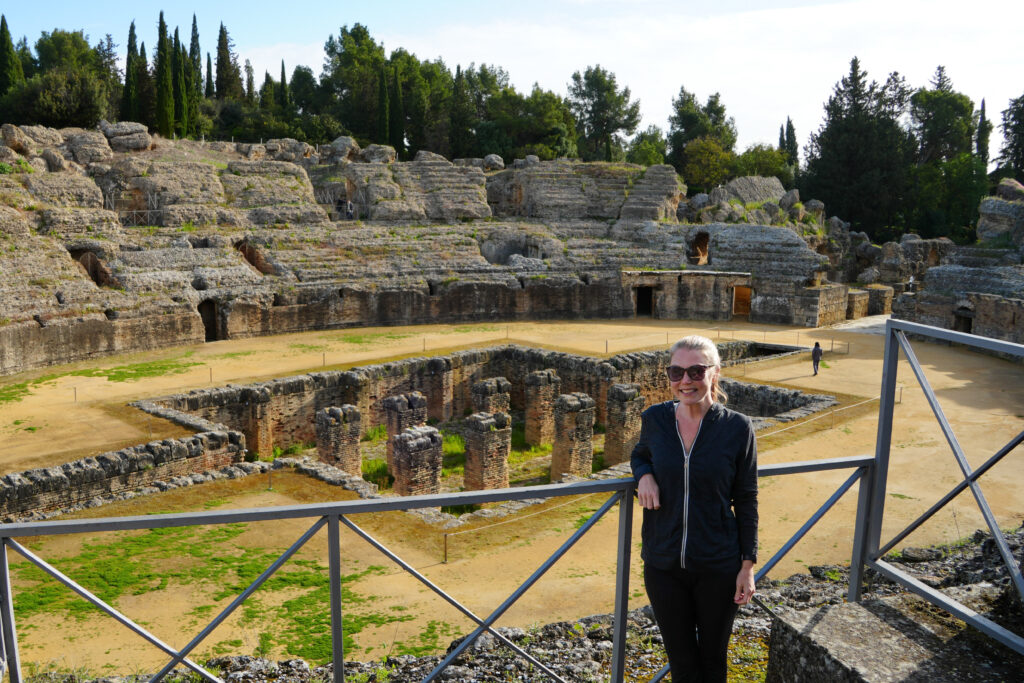
The most notable site in Italica is its amphitheater. It was one of the largest amphitheaters in the Roman Empire (4th largest according to UNESCO). It was built during the reign of emperor Hadrian approximately between the years 117 and 138 CE. The information presented at the archeological site of Italica said that it could hold 35,000 spectators, though I’ve read 25,000 from some other sources. The city was an important place for celebrations and would host gladiator games in this amphitheater.
Huge mansions with impressive mosaic floors were a short walk from the amphitheater. Some of the mosaics have interesting themes like birds or the planetary gods that the days of the week were named after.
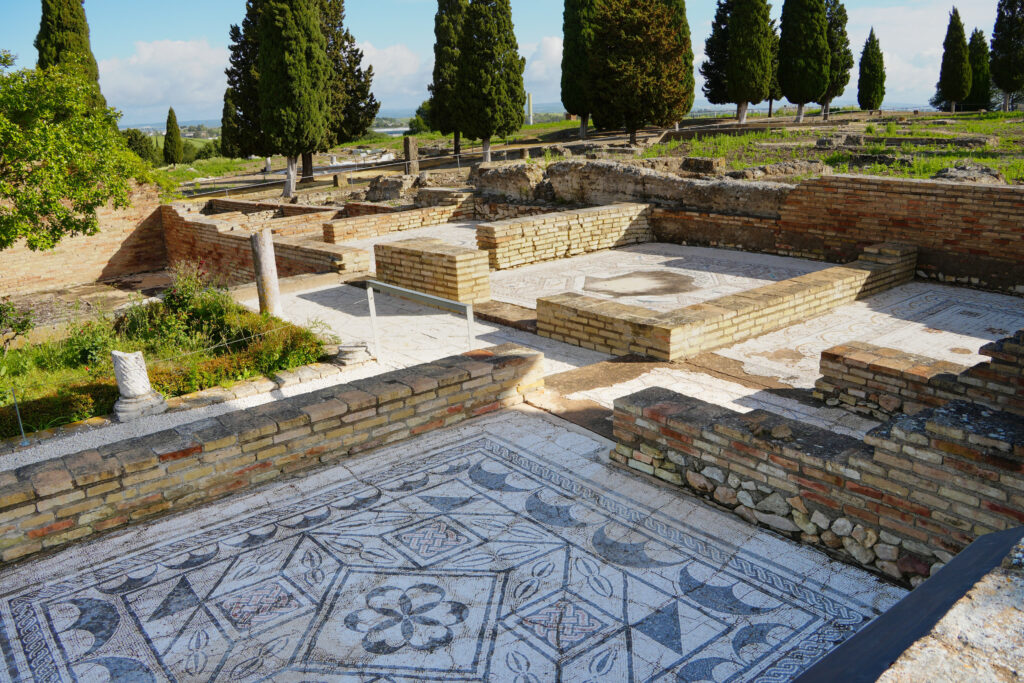
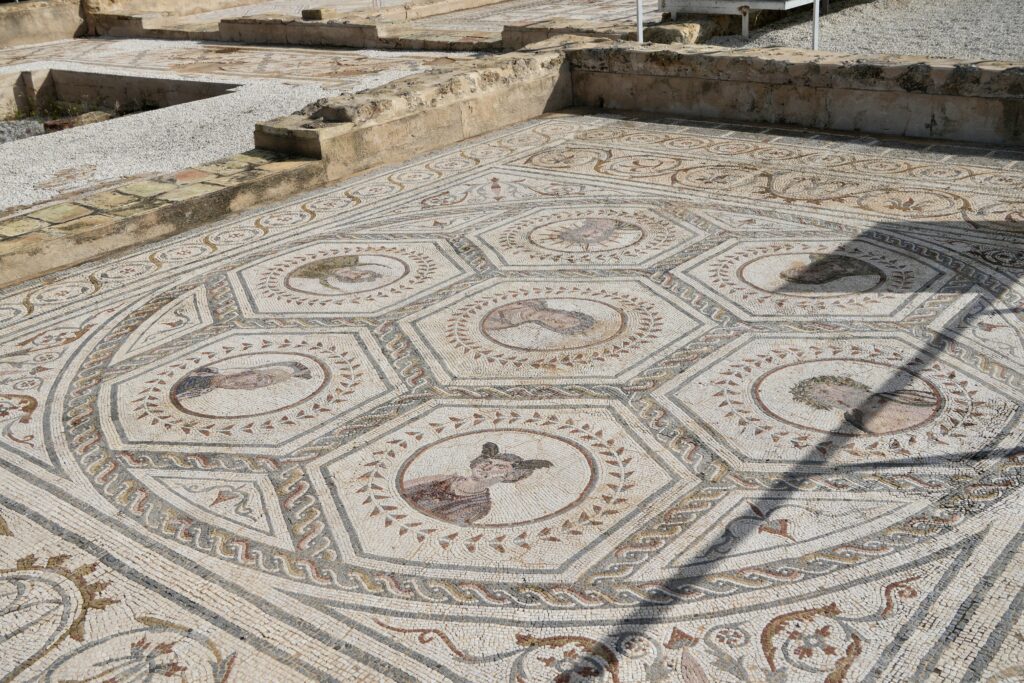
A Roman Theatre is also here, but it is outside the gates of the archeological site. It is in town and has homes built around half of it. It wasn’t open when we visited, but we walked around it and could see into it from a couple places.
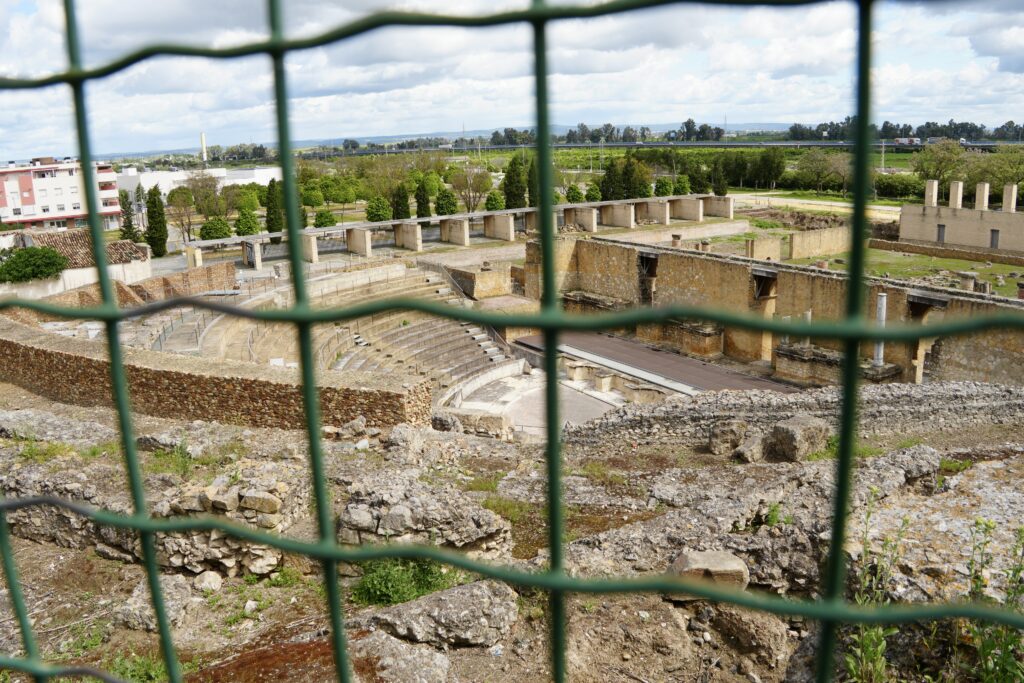
The Palace of the Countess of Lebrija (Casa Palacio de la Condesa de Lebrija)
This 16th century palace was bought by the Countess of Lebrija in 1901. She restored the building and used it to house her collection of historic items. The palace is beautiful through not in the best condition. The main reason (in my opinion) to visit is to see the mosaics. It contains large mosaic floors that came from Italica. Some smaller mosaics are displayed on the walls as well. There are also a couple sculptures that came from Italica.
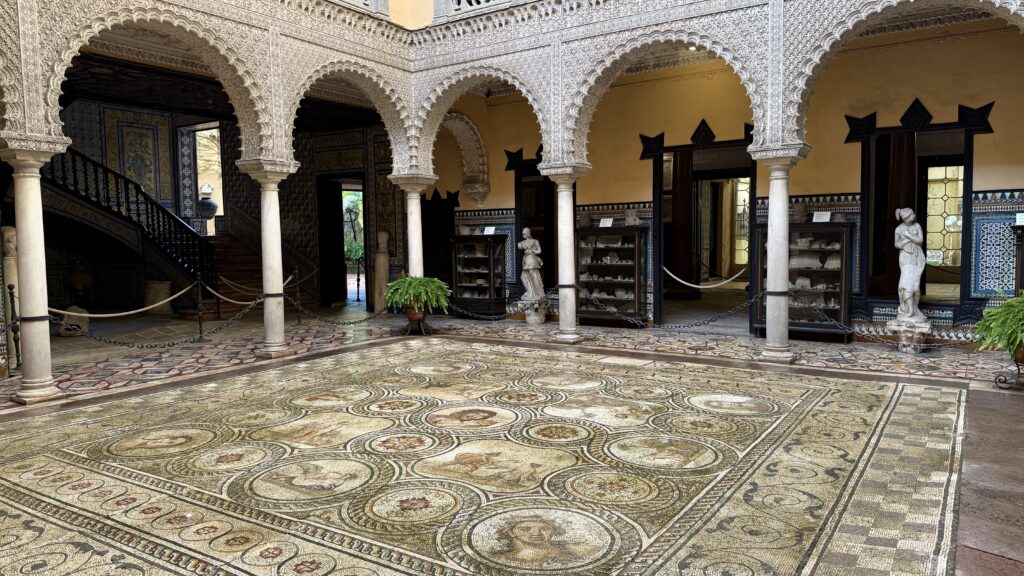
The cost is quite high to visit, but they do currently offer free entry to just the bottom floor (where the mosaics are) on Fridays at 10am. It is limited so get there early and wait in line. We arrived 30 minutes early and were first in line.
Seville Cathedral
Seville Cathedral is the 3rd largest cathedral and the largest gothic cathedral in the world. Non-guided entrance was sold out when we tried to book so we did the tour. We were actually happy that we ended up on the tour because our guide took us into areas that you can only access with a guide like the choir chamber and inside some of the side chapels.
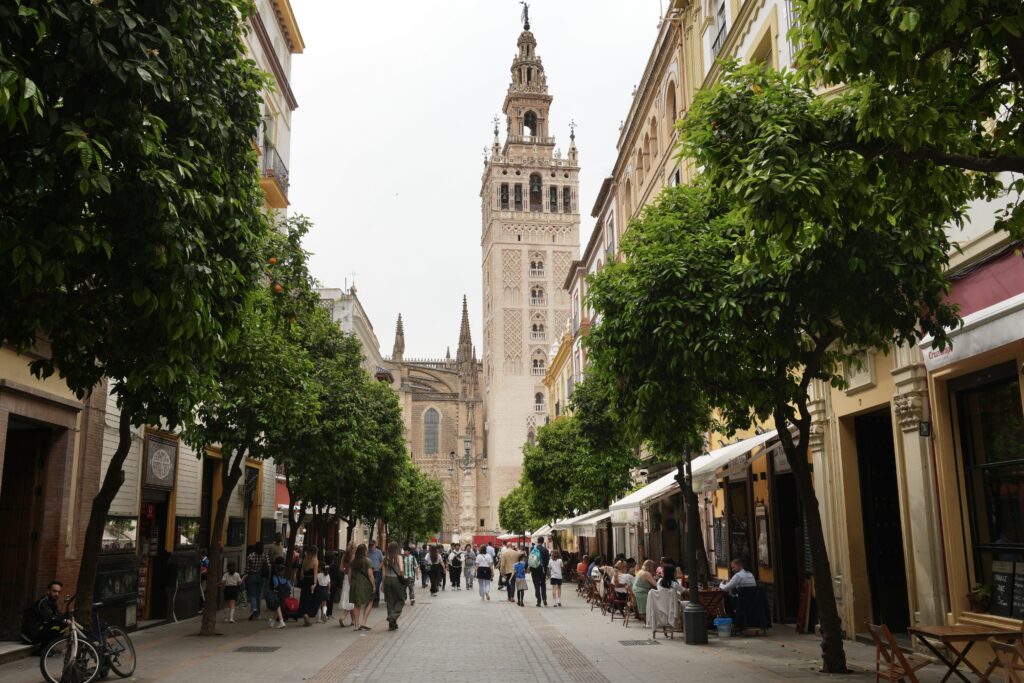
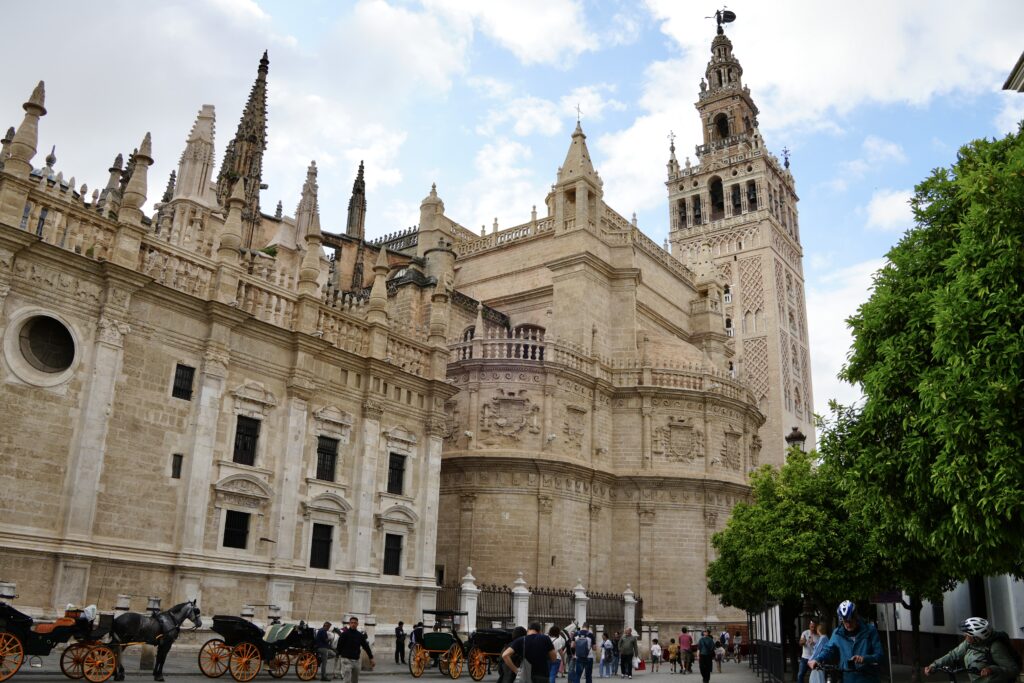
Christopher Columbus has an interesting tomb inside the cathedral. His tomb is held up by 4 statues that represent the four kingdoms that came together to create modern day Spain.
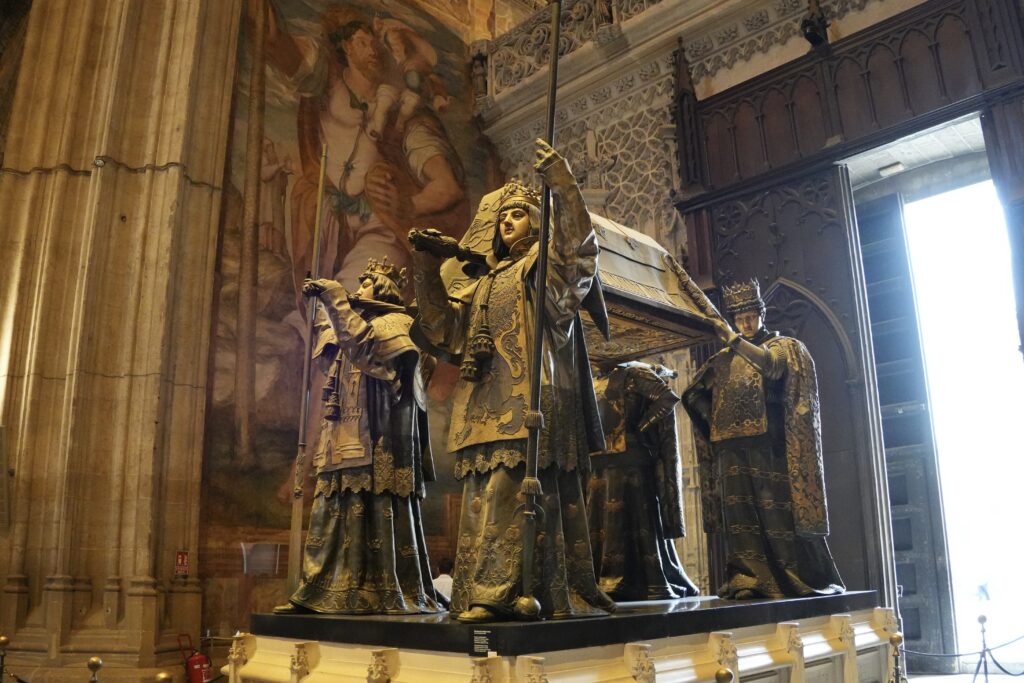
Plaza de España
Plaza de España in Maria Luisa Park is the beautiful plaza that you most often see when searching for photos of Seville. It was built for the Ibero-American Exposition of 1929. The large park that it resides in is full of fountains, trees, and birds.
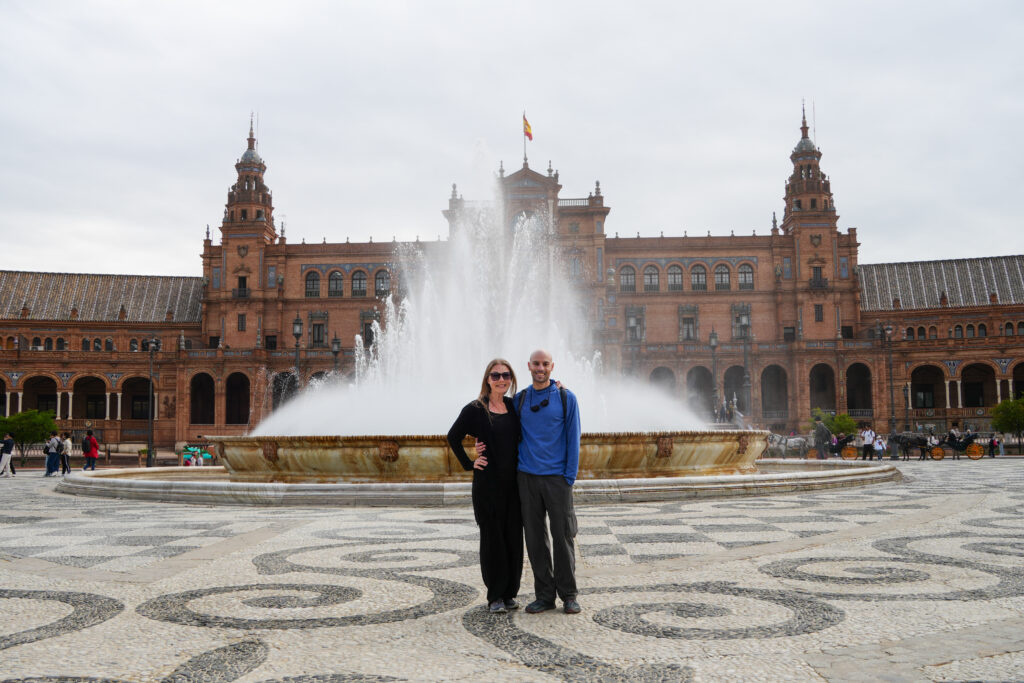
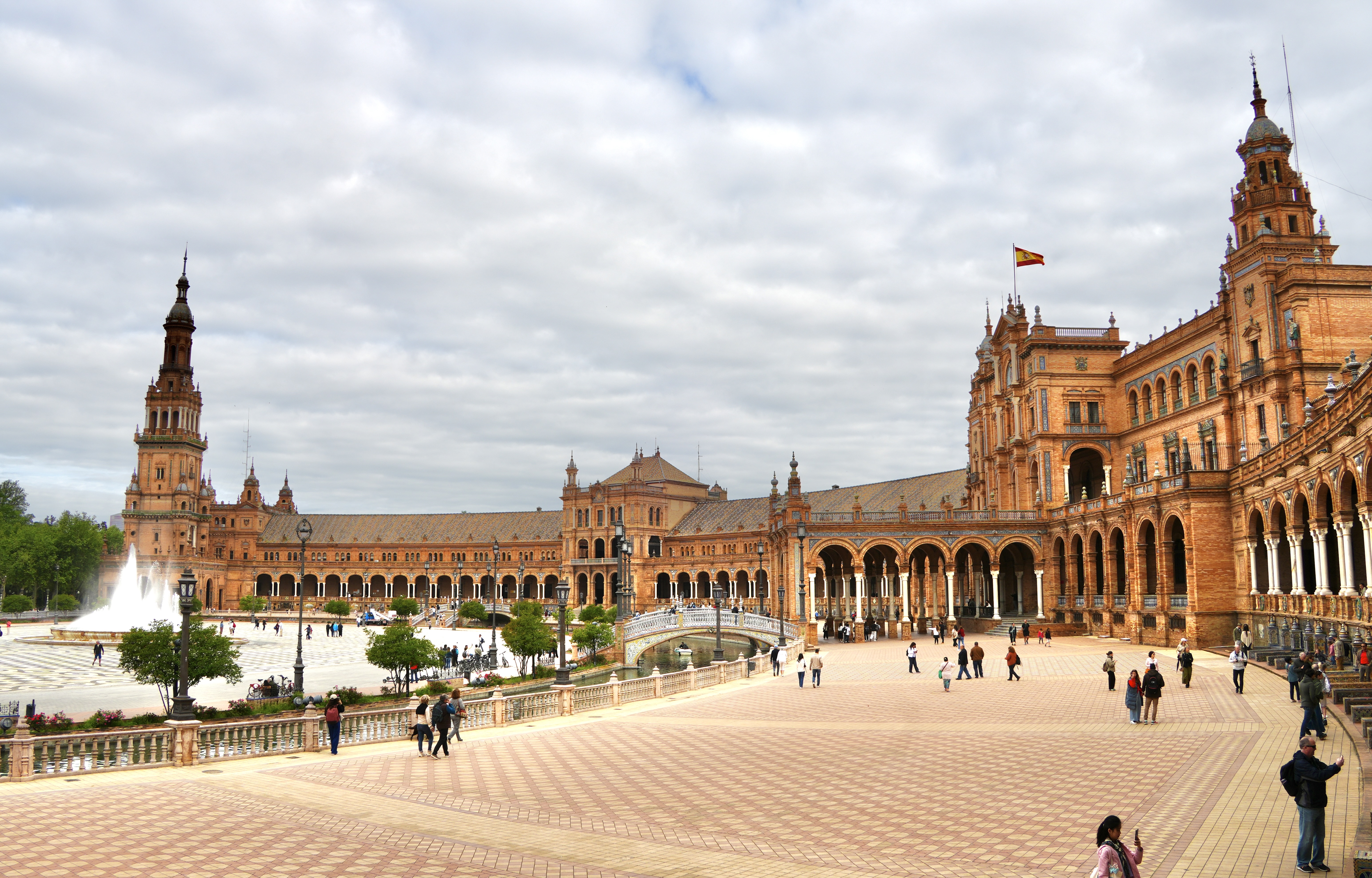
Holy Week in Seville (Easter Celebrations)
We hadn’t realized that Seville was the top place in Andalucia to celebrate Easter, so we were excited to realize we would be here for some of the festivities. We were in Seville for Palm Sunday and until the Friday before Easter.
Holy Week has been celebrated in Seville since the 16th century with daily processions. Every afternoon and evening from Palm Sunday through Easter Sunday, processions fill the streets. Each procession has members from that brotherhood in their distinctive robes walking, a float portraying Christ being carried, and a marching band playing music. The processions walk from their church to the Seville Cathedral. The streets are crowded with locals and visitors excited to see the processions.
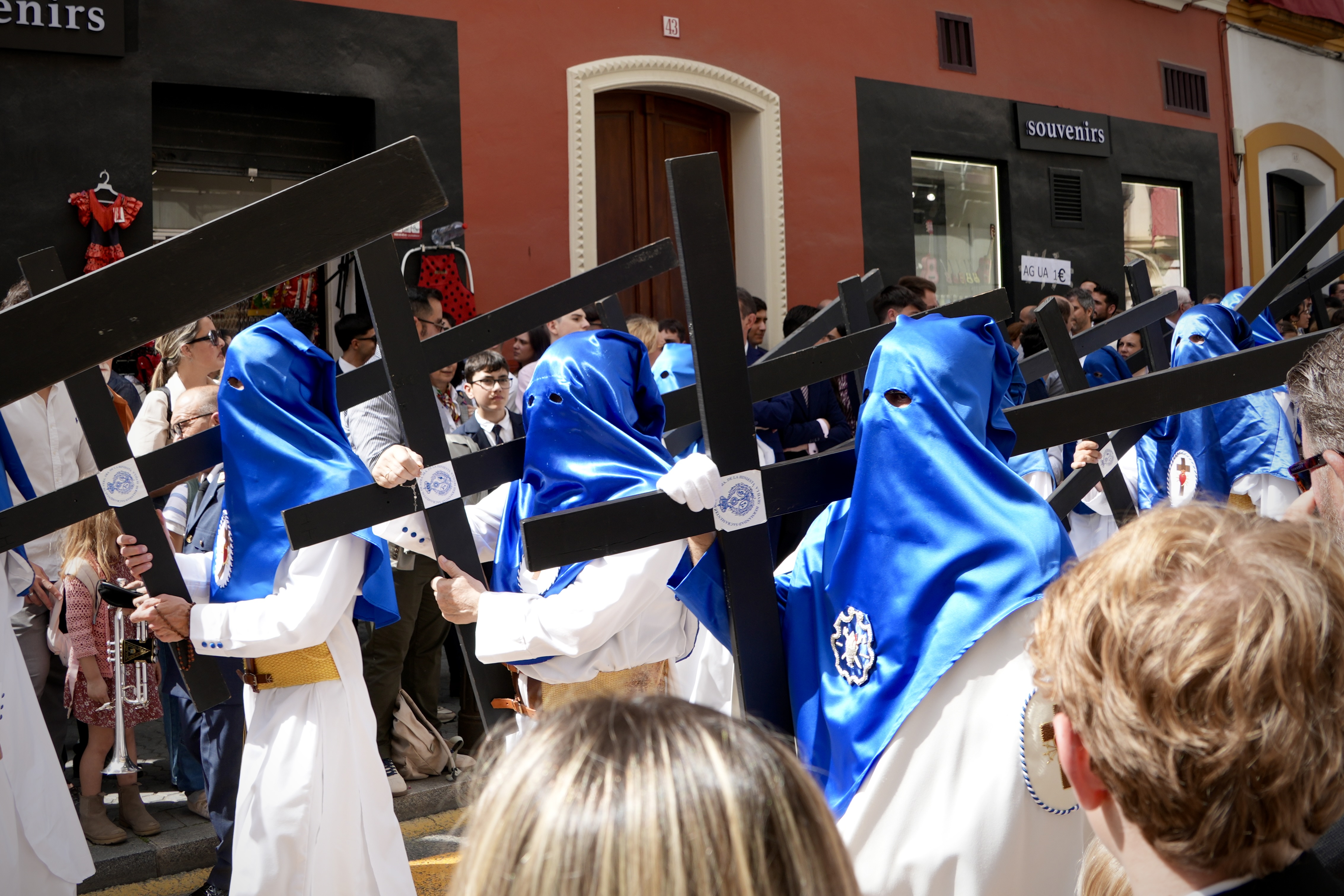
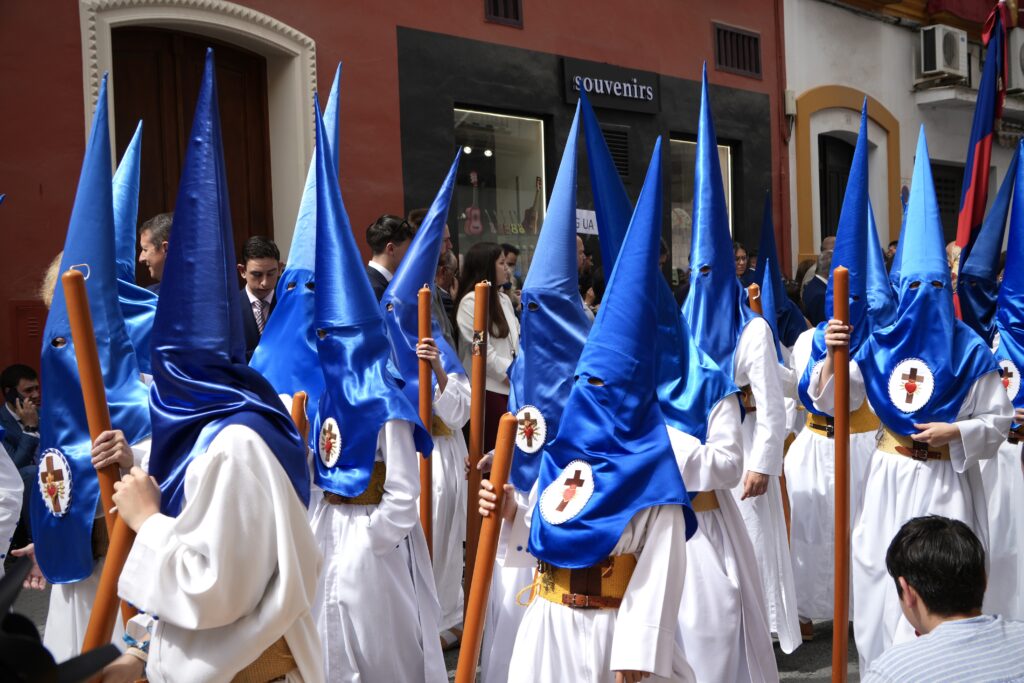
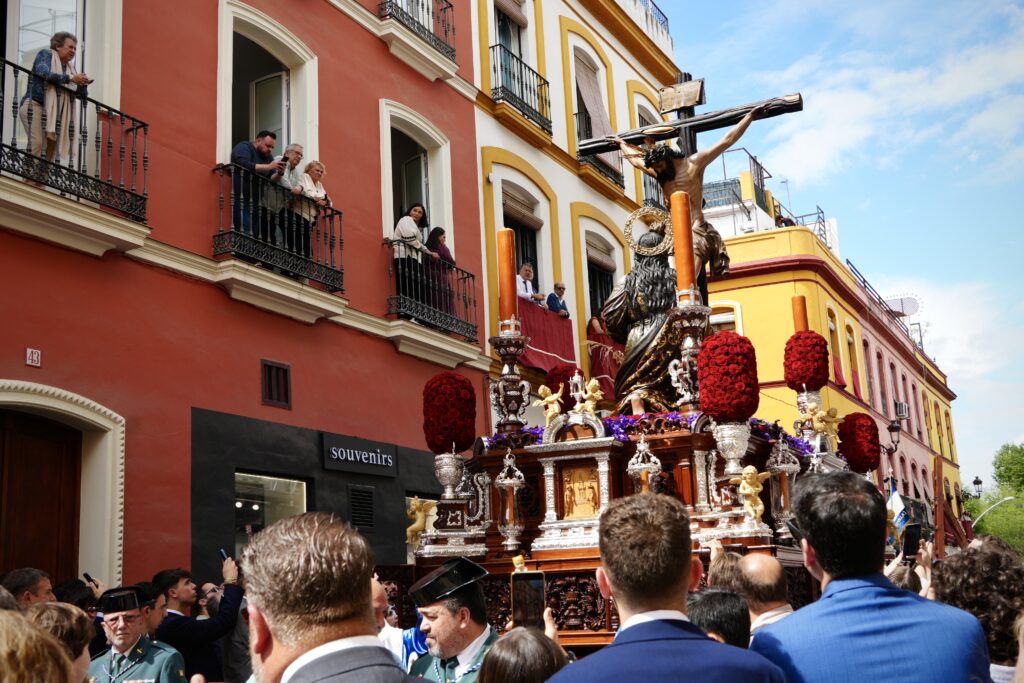
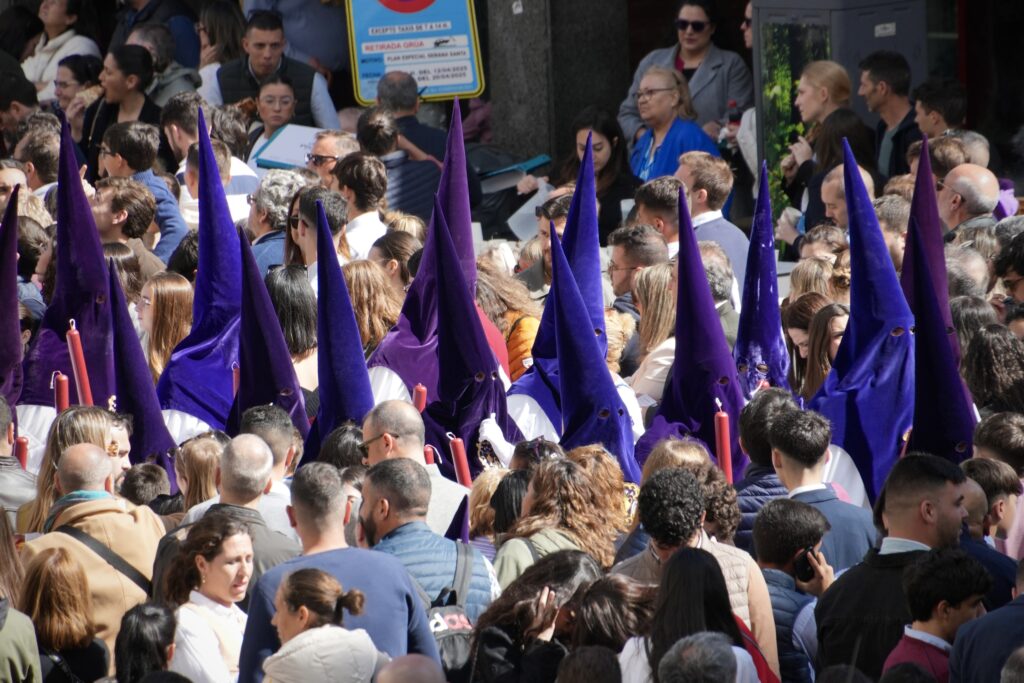
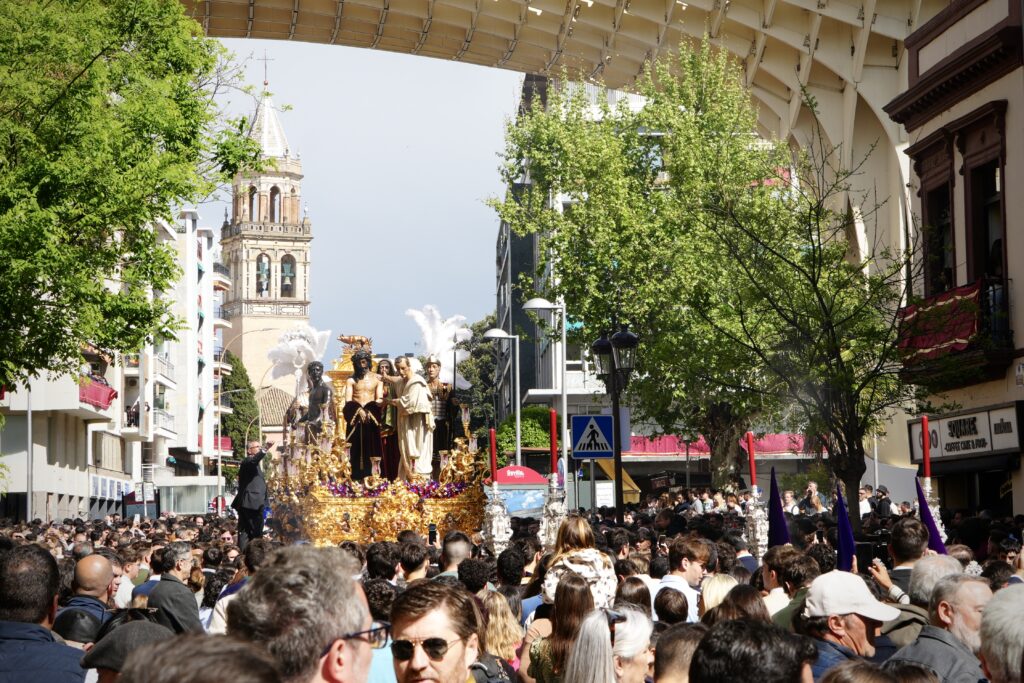
Conclusion
We loved learning about the history of Andalucia, Spain. With our itinerary we saw Roman, Muslim, and Catholic era sites. Every place we visited was interesting and each destination seemed to build on what we had already seen and learned about.
While I loved each place we visited, if you don’t have enough time to go to all these cities, I would prioritize Granada and Seville. The sites I most recommend are The Alhambra in Granada and Italica near Seville. Then I would add Córdoba if possible for the Mosque-Cathedral.
I hope you enjoyed getting a glimpse into this region and if you are planning to visit, a sense of what to prioritize seeing.
Leave a Reply